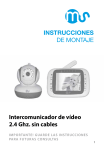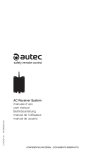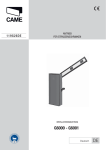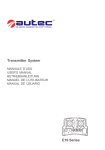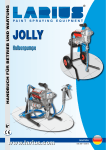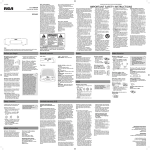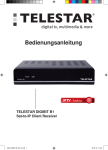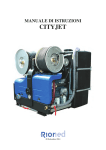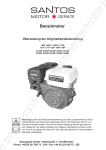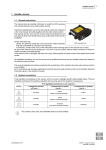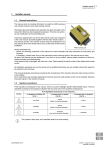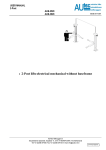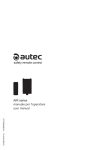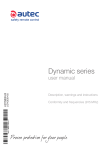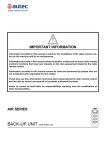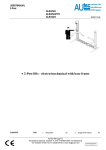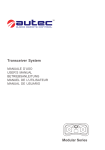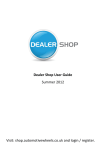Download Copertina esterna fronte LIE&LQU4-01_fede.cdr
Transcript
Rail mounted receiver Manuale d’uso User Manual Betriebsanleitung Manuel de l’utilisateur Manual de usuario Rail mounted receiver Manuale d’uso User Manual Betriebsanleitung Manuel de l’utilisateur Manual de usuario ITALIANO Per le indicazioni ed avvertenze relative alla macchina comandata dal radiocomando, seguire attentamente quelle fornite dal costruttore della macchina stessa. In caso di danneggiamento o smarrimento del presente manuale, è necessario chiederne copia ad AUTEC specificando il numero di matricola del radiocomando ad esso legato. Contattare AUTEC qualora alcune istruzioni e/o avvertenze del presente manuale non risultassero chiare. Le informazioni contenute nel presente manuale sono soggette a modifiche senza preavviso e non rappresentano un impegno da parte di AUTEC. Per nessun motivo possono essere riprodotte, in qualsiasi forma/mezzo parti del libretto senza permesso scritto di AUTEC (inclusa registrazione e fotocopia). ENGLISH Follow the indications and warnings given by the machine producer regarding the machine on which the radio remote control is installed. If this manual is lost or damaged, ask for a copy from Autec. Please specify the serial number of the related radio remote control. Contact AUTEC if any of the instructions and/or warnings given in this manual is not clear. The information contained in this manual is subject to modification without notice and is not binding. No part of this manual may be reproduced, in any form or by any means, without written permission of Autec (including recording and photocopying). DEUTSCH Für Anleitungen und Warnungen, die die von der Funkfernsteuerung gesteuerte Maschine betreffen, ist laut Anweisungen des Maschinenherstellers vorzugehen. Im falle einer Beschädigung oder eines Abhandenkommens der vorliegenden Betriebsanleitungen, ist es notwendig, eine weitere Kopie derselben von AUTEC zu erfragen. Dabei sollte man die Seriennummer der Funkfernsteuerung angeben. Wenden Sie sich bitte an AUTEC, falls einige Anleitungen und/oder Warnungen der vorliegenden Betriebsanleitung nicht klar sein sollten. Im Sinne ständiger Verbesserung aller Erzeugnisse der AUTEC srl behalten wir uns Änderungen im Design und in den technischen Daten ohne vorgehende Bekanntgabe vor. Ohne schriftliche Genehmigung der AUTEC srl darf diese Betriebsanleitung in keiner Form, auch nur auszugsweise, reproduziert werden (einschließlich Aufnahme und Fotokopien). FRANÇAIS Pour les indications et les précautions concernant la machine commandé par la radiocommande, suivre ce qui est indiqué par le constructeur de la machine. En cas d'endommagement ou de perte du présent manuel, il est nécessaire d'en demander une copie à Autec en spécifiant le numéro de matricule de la radiocommande qui lui est associée. Contacter AUTEC si certaines instructions et/ou avertissements du présent manuel n'étaient pas clairs. Les informations contenues dans le présent manuel sont sujettes à modifications sans préavis et ne sont données qu'à titre indicatif (document non contractuel). Toute reproduction de ce manuel, en tout ou en partie, sous quelque forme ou moyen que ce soit, est interdite sans l'autorisation écrite d'Autec srl (y compris l'enregistrement et la photocopie). ESPAÑOL ESPAÑOL Por lo que concierne a las indicaciones y advertencias relativas a la máquina dirigida por el telemando de radio, seguir las indicaciones del constructor de la máquina. En caso de daño o perdida de este manual, hay que pedir una copia a Autec especificando el relativo número del telemando de radio. Contactar AUTEC cuando algunas instrucciones o advertencias no fueran claras en este manual. Las informaciones contenidas en el presente manual estan sujetas a modificaciones sin preaviso por parte de Autec. Bajo ningún motivo y de ninguna forma ni medio puede ser reproducido total o parcialmente el contenido de este manual sin el permiso escrito de Autec. 1 INDICE E CONVENZIONI 1 1.1 1.2 2 2.1 2.2 2.3 3 3.1 3.2 3.3 4 5 5.1 5.2 5.3 6 6.1 6.2 6.3 7 8 8.1 9 Indice e convenzioni.............................................................................................. 1 Indice ....................................................................................................................... 1 Convenzioni ............................................................................................................. 1 Introduzione ........................................................................................................... 2 Descrizione generale ............................................................................................... 2 Documentazione ...................................................................................................... 3 Dati tecnici generali.................................................................................................. 4 Unità ricevente ....................................................................................................... 5 Unità ricevente ......................................................................................................... 5 Estensione unità ricevente....................................................................................... 5 Dati tecnici unità ricevente ed estensione................................................................ 6 Avvertenze per l’installazione............................................................................... 7 Avvertenze per la manutenzione .......................................................................... 8 Manutenzione ordinaria ........................................................................................... 8 Manutenzione straordinaria (SERVICE AUTEC) ..................................................... 9 Rottamazione........................................................................................................... 9 Installazione ......................................................................................................... 10 Montaggio su guida DIN ........................................................................................ 10 Cablaggio............................................................................................................... 11 Montaggio antenna ................................................................................................ 12 Segnalazioni luminose ........................................................................................ 13 Programmazioni................................................................................................... 14 Programmazione modulo radio ricevente E16SRXEU_ ........................................ 14 Diagnostica unità ricevente ................................................................................ 15 1.2 CONVENZIONI In questo manuale, tutte le informazioni importanti vengono evidenziate con le seguenti simbologie e convenzioni: abcd… : AVVERTENZE abcd… : DATI TECNICI abcd… : TESTI IMPORTANTI IL PRESENTE MANUALE FA RIFERIMENTO ESCLUSIVAMENTE ALL’UNITÀ RICEVENTE: LE AVVERTENZE RELATIVE ALL’USO SONO PRESENTI NEL MANUALE DELL’UNITÀ TRASMITTENTE. PRIMA DI INSTALLARE, METTERE IN FUNZIONE E UTILIZZARE IL RADIOCOMANDO, IL PRESENTE MANUALE DEVE ESSERE LETTO E CAPITO ATTENTAMENTE DA TUTTE LE PERSONE ADDETTE ALL’INSTALLAZIONE, ALL’USO E ALLA MANUTENZIONE. LIE&LQU4-01 - ita.fm 1 - Indice e convenzioni Pagina 1 Italiano 1.1 INDICE 2 INTRODUZIONE Italiano 2.1 DESCRIZIONE GENERALE I radiocomandi industriali sono utilizzati per comandare macchine da posizione remota. Ogni radiocomando industriale è costituito da un’unità trasmittente portatile da cui l’operatore può comandare a distanza la macchina e da un’unità ricevente installata a bordo della macchina stessa. L’unità trasmittente, attraverso una trasmissione a radiofrequenza, invia un messaggio codificato. In questo messaggio è presente un valore detto indirizzo (address). Ogni unità ricevente può decodificare esclusivamente i messaggi provenienti dalla unità trasmittente che possiede lo stesso indirizzo. Ciò esclude che un’interferenza possa attivare una qualunque funzione del sistema. Infatti, se la trasmissione a radiofrequenza risulta disturbata, errata o interrotta, l’unità ricevente arresta autonomamente l’intero sistema. Unità ricevente Unità trasmittente Ogni radiocomando è conforme alla Direttiva R&TTE 99/05/CE e ai suoi requisiti essenziali. Ogni radiocomando è inoltre conforme alle norme riportate nella dichiarazione di conformità CE allegata a questo manuale. Autec non potrà assumersi alcuna responsabilità se il radiocomando è installato su applicazioni diverse da quelle consentite: APPLICAZIONI CONSENTITE Macchine per sollevamento materiali (gru edili, carroponti, macchine per la movimentazione materiale in genere,…). APPLICAZIONI NON CONSENTITE Macchine per ambienti che necessitano di apparecchiature con caratteristiche di antideflagrazione. Macchine per la movimentazione, il sollevamento e il trasporto di persone. LIMITAZIONI & AUTORIZZAZIONI Si ricorda che in taluni stati si devono rispettare leggi che regolamentano: - l’uso e/o il possesso di un radiocomando - l’utilizzo delle frequenze di lavoro non ancora armonizzate nei paesi europei. Nell’allegato “Limitazioni & Autorizzazioni” al presente manuale è possibile trovare tutte le indicazioni da osservare. Pagina 2 2 - Introduzione LIE&LQU4-01 - ita.fm Per garantire il corretto utilizzo del radiocomando, devono essere sempre rispettate tutte le prescrizioni vigenti sulla sicurezza del lavoro e sulla prevenzione degli infortuni sul lavoro. Inoltre, si devono sempre osservare tutte le leggi nazionali relative all’uso sia della macchina che del radiocomando vigenti nel singolo stato dove il sistema è utilizzato. Autec non potrà assumersi alcuna responsabilità se il radiocomando è utilizzato in condizioni lavorative non a norma. In caso di guasto o emergenza, si deve mettere fuori servizio il sistema “macchina+radiocomando” fino alla completa eliminazione del problema esistente. Eventuali parti danneggiate possono essere sostituite SOLTANTO da personale autorizzato Autec, utilizzando ESCLUSIVAMENTE parti di ricambio originali Autec. 2.2 DOCUMENTAZIONE La documentazione allegata ad ogni radiocomando è composta almeno da: - manuale dell’unità trasmittente - manuale dell’unità ricevente - manuale del caricabatterie - dichiarazione di conformità CE - certificato di garanzia - scheda tecnica - allegato “Limitazioni & Autorizzazioni”. Verificare che siano presenti questi documenti allegati: in caso contrario farne richiesta ad Autec specificando il numero di matricola del radiocomando. Certificato di garanzia Le condizioni che regolano la garanzia del radiocomando sono riportate sul “Certificato di Garanzia”. Scheda tecnica La scheda tecnica rappresenta lo schema di cablaggio tra l’unità ricevente e la macchina. Deve essere compilata e controllata dall’installatore il quale ha la responsabilità del corretto cablaggio. Effettuate queste necessarie verifiche, l’installatore deve firmare la scheda tecnica che deve rimanere allegata al manuale d’uso (nel caso in cui la si utilizzi per pratiche amministrative tenerne sempre una copia). LIE&LQU4-01 - ita.fm 2 - Introduzione Pagina 3 Italiano Come richiesto dalla Direttiva Macchine e dalle relative norme armonizzate, è necessario effettuare per ogni macchina un’analisi dei rischi: pertanto, in caso di utilizzo di un radiocomando, occorre valutare all’interno di questa analisi se la macchina può essere radiocomandata o meno. La responsabilità di questa analisi è del costruttore della macchina stessa e/o di chi decide l’installazione e l’uso del radiocomando. Autec non potrà assumersi alcuna responsabilità se questa analisi dei rischi non è stata effettuata in maniera corretta. Italiano Targhette identificazione I dati di identificazione e di omologazione del radiocomando sono riportati su apposite targhette sia sull’unità trasmittente che sull’unità ricevente. Tali targhette NON DEVONO essere: - rimosse dalla loro posizione (la rimozione comporta l'immediata decadenza della garanzia) - alterate o rovinate (contattare Autec per la sostituzione). 2.3 DATI TECNICI GENERALI Banda di frequenze con modulo radio E16SRXEU1 * .............. 434.040 - 434.790 MHz ...................................................................................... oppure 433.050 - 434.790 MHz Banda di frequenze con modulo radio E16SRXEU2 ................ 869.700 - 870.000 MHz Canali radio utilizzabili ...................................................... 16 (434.040 - 434.790 MHz) .......................................................................................... 32 (433.050 - 434.790 MHz) .......................................................................................... 12 (869.700 - 870.000 MHz) Canalizzazione utilizzata .................................................................................... 25 kHz Distanza di Hamming................................................................................................ ≥ 8 Probabilità di mancata rilevazione dell’errore .............................................. <10 exp-11 Raggio d’azione tipico.......................................................................................... 100 m Tempo di risposta dei comandi....................................................................... ~ 100 ms Tempo di risposta comando di STOP............................................................. ~ 100 ms Tempo di emergenza passiva (o arresto passivo) **..................................... 0.35/1 sec. * ** vedere allegato “Limitazioni & Autorizzazioni” per scegliere la banda di lavoro consentita e il paragrafo 8 "Programmazioni" per l’eventuale impostazione. vedere paragrafo 8 "Programmazioni", impostazioni DIP n°1. Per le caratteristiche del mezzo radio (es. presenza interferenze, raggiunto limite di portata), il ritardo tra il rilascio di un comando e la disattivazione della relativa uscita può arrivare fino ad 1 secondo. E’ necessario assicurarsi che questo non possa mai portare ad una situazione di pericolo nella specifica applicazione. Pagina 4 2 - Introduzione LIE&LQU4-01 - ita.fm L’unità ricevente Type R102 può essere utilizzata con le unità trasmittenti delle seguenti serie: - SERIE E16 - SERIE MODULAR - SERIE LIGHT 3.1 UNITÀ RICEVENTE F1 E F2 F3 D A B C A segnalazioni luminose B targhetta dati tecnici C targhetta di identificazione D morsettiera di uscita E morsettiera d’alimentazione F1/F2 F3 fusibili G connettore per l’antenna G Queste unità riceventi sono dotate di una funzione di sicurezza chiamata SAFETY che protegge il sistema “macchina+radiocomando”, in posizione neutra (di riposo), dai movimenti involontari dovuti ad eventuali guasti del radiocomando. Ciò avviene solo se vengono rispettate sia le indicazioni di cablaggio fornite nella scheda tecnica sia le indicazioni per una corretta installazione riportate nel seguente manuale. ALIMENTARE L’UNITÀ RICEVENTE MEDIANTE UN TRASFORMATORE DI SICUREZZA (vedere EN 60204-32 paragrafo 6.4). 3.2 ESTENSIONE UNITÀ RICEVENTE È possibile utilizzare un’estensione dell’unità ricevente che aggiunge ulteriori 6 comandi a quelli presenti. D F4 D G LIE&LQU4-01 - ita.fm morsettiera di uscita F4 fusibile G cavetto di collegamento estensione unità ricevente 3 - Unità ricevente Pagina 5 Italiano 3 UNITÀ RICEVENTE Italiano 3.3 DATI TECNICI UNITÀ RICEVENTE ED ESTENSIONE Condizioni climatiche FUNZIONAMENTO IMMAGAZZINAMENTO TRASPORTO TEMPERATURA UMIDITÀ RELATIVA PRESSIONE DELL’ARIA Classe 4K4H Classe 4K4H Classe 4K4H da -20°C a +70°C da 4% a 100% da 86 kPa a 106 kPa Classe 1K5 Classe 1K3 Classe 1K4 da -40°C a +70°C da 5% a 95% da 86 kPa a 106 kPa Classe 2K3 Classe 2K3 Classe 2K3 da -25°C a +70°C 95% da 70 kPa a 106 kPa Portata dei contatti di SAFETY ................................................................... 4A (250Vac) Portata dei contatti di comando.................................................................. 4A (250Vac) Custodia .......................................................................................................... NORIL ® Grado di protezione................................................................................................. IP20 Unità ricevente Tensione di alimentazione .................................................. Nom. 12 -24 Vac/dc (~7 W) ............................................................................................. Max. 10 -30 Vac/dc (~7 W) Antenna............................................................................................................ dedicata Numero comandi disponibili ............................................................... 14 (+ start + stop) Portata dei contatti di STOP........................................................................ 4A (250Vac) Fusibile F3 (circuito di STOP) ......................................................4A T 250V (5x20 mm) Fusibile F2 (circuito di SAFETY) ..................................................4A T 250V (5x20 mm) Fusibile F1 (POWER SUPPLY) ...................................................1A T 250V (5x20 mm) Dimensioni ..................................................................................... (160 x 110 x 75) mm Peso ...................................................................................................................... 500 g Estensione unità ricevente Numero comandi disponibili ......................................................................................... 6 Fusibile F4 (circuito di SAFETY) ..................................................4A T 250V (5x20 mm) Dimensioni ....................................................................................... (72 x 110 x 75) mm Peso ...................................................................................................................... 200 g Pagina 6 3 - Unità ricevente LIE&LQU4-01 - ita.fm L’installazione deve essere eseguita esclusivamente da personale qualificato, secondo le disposizioni del Paese in cui si effettua tale operazione. L’installatore DOVRÀ SEMPRE rispettare le seguenti avvertenze: POSIZIONARE l’unità ricevente in modo che la morsettiera di uscita sia sempre rivolta verso l’alto. NON MODIFICARE o MANOMETTERE né il radiocomando, né la macchina né il suo quadro elettrico. NON PERFORARE in nessun caso l’unità ricevente. EFFETTUARE il cablaggio osservando tutte le norme riguardanti i quadri elettrici e i regolamenti nazionali applicabili. Seguire le indicazioni e avvertenze riportate nel capitolo “Installazione” a pagina 10. NON ELUDERE i meccanismi di sicurezza previsti sul radiocomando e/o presenti all’interno della macchina. RISPETTARE le imposizioni della norma EN 60204-32 (per macchine di sollevamento) e/o EN 60204-1 (per macchine). INSTALLARE l’unità ricevente esclusivamente all’interno di quadri elettrici. UTILIZZARE quadri elettrici che garantiscano un grado di protezione maggiore o uguale a IP54 (consigliato IP65 se il quadro è all’aperto). INSTALLARE l’unità ricevente lontana da qualunque componente che generi campi elettromagnetici e/o calore (per es. trasformatori). PRESTARE particolare attenzione nel cablare il contatto di SAFETY in serie al comune dei comandi di movimento. Dopo l’installazione ed il cablaggio, VERIFICARE SEMPRE l’esatta corrispondenza tra comandi inviati e manovre effettuate (in particolare il comando di STOP). TOGLIERE L’ALIMENTAZIONE scollegando tutte le connessioni elettriche ogni volta che si effettua una saldatura sulla macchina (sia che ciò capiti durante l’installazione che durante il normale funzionamento). La presenza di vibrazioni può compromettere le prestazioni dell’unità ricevente: si consiglia in questo caso di utilizzare appositi sistemi antivibranti. Tra le operazioni di installazione è compreso anche il montaggio dell’antenna (per istruzioni ed avvertenze vedere paragrafo 6.3 "Montaggio antenna"). L’installatore deve VERIFICARE e/o COMPILARE in tutte le sue parti la “Scheda Tecnica” ponendo la data di messa in funzione dell’impianto con timbro e firma. LIE&LQU4-01 - ita.fm 4 - Avvertenze per l’installazione Pagina 7 Italiano 4 AVVERTENZE PER L’INSTALLAZIONE Italiano 5 AVVERTENZE PER LA MANUTENZIONE Durante tutte le operazioni di manutenzione, IL PERSONALE ADDETTO DOVRÀ ACCERTARSI CHE VENGA TOLTA L’ALIMENTAZIONE ALL’UNITÀ RICEVENTE. Tutti gli interventi di controllo e di manutenzione del radiocomando vanno verificati e registrati dal Responsabile della Manutenzione della macchina. La manutenzione ordinaria secondo le istruzioni contenute in questo manuale è fondamentale per il funzionamento sicuro del radiocomando. Dopo ogni intervento di manutenzione, verificare sempre che i comandi inviati dall’unità trasmittente attivino esclusivamente le manovre previste. 5.1 MANUTENZIONE ORDINARIA Le istruzioni che seguono permettono di mantenere il radiocomando in perfette condizioni, garantendo un funzionamento sicuro e corretto per un lungo periodo. Particolari applicazioni possono richiedere interventi di manutenzione ordinaria più specifici e con tempistiche diverse. Queste istruzioni non sostituiscono in nessun caso le norme e le leggi in materia di sicurezza del lavoro, né limitano le responsabilità dell’acquirente e dell’utilizzatore del radiocomando. Tutte le istruzioni riportate devono essere eseguite ad ogni messa in servizio della macchina e del radiocomando. Manutenzione semestrale 1. verificare il corretto funzionamento dei contatti di tutti i relè dell'unità ricevente, controllando la chiusura del contatto all'attivazione della corrispondente manovra e apertura del contatto alla disattivazione della manovra 2. verificare la corretta corrispondenza tra comandi inviati e manovre eseguite 3. verificare che il contatto del relè di SAFETY sia aperto quando nessun comando di movimento è inviato. Questa manutenzione è importante per la sicurezza. Manutenzione annuale 1. controllare che le unità siano strutturalmente integre 2. verificare l'integrità e la connessione dei cavi e morsetti 3. controllare la leggibilità e l'integrità della targhetta identificativa 4. verificare ed eventualmente sostituire le fascette o altri sistemi di fissaggio. Pagina 8 5 - Avvertenze per la manutenzione LIE&LQU4-01 - ita.fm Eventuali guasti possono esclusivamente essere riparati da personale autorizzato (interpellare il SERVICE AUTEC), utilizzando soltanto parti di ricambio originali Autec. Per rendere possibile un intervento più veloce ed efficace, devono essere comunicati i dati per una corretta e completa identificazione del radiocomando: - numero di matricola - data di acquisto (riportata sul certificato di garanzia) - anomalia riscontrata - indirizzo e numero di telefono del luogo in cui è utilizzato (e il nome del responsabile da contattare) - ditta fornitrice. Prima di far intervenire i tecnici del SERVICE AUTEC, è opportuno aver letto e capito in tutte le sue parti il presente manuale, verificando di aver eseguito correttamente tutte le istruzioni riportate. 5.3 ROTTAMAZIONE Per la rottamazione, affidare il radiocomando al servizio recupero differenziato dei rottami esistente nel territorio. In particolare fare attenzione nel riciclare le batterie applicando le disposizioni locali. Non gettarle assieme ai rifiuti domestici. LIE&LQU4-01 - ita.fm 5 - Avvertenze per la manutenzione Pagina 9 Italiano 5.2 MANUTENZIONE STRAORDINARIA (SERVICE AUTEC) 6 INSTALLAZIONE Italiano 6.1 MONTAGGIO SU GUIDA DIN All’interno di un quadro elettrico, l’unità ricevente deve essere installata esclusivamente su una guida DIN EN 60 715. Seguire le seguenti istruzioni per realizzare un facile e rapido montaggio e smontaggio. MONTAGGIO 1. Agganciare la parte superiore della sede dell’unità alla guida DIN. 2. Spostare verso il basso il gancio presente sul fondo dell’unità, facendo pressione con un cacciavite finché l’unità si incastra perfettamente alla guida DIN. SMONTAGGIO Spostare verso il basso il gancio presente sul fondo dell’unità, facendo pressione con un cacciavite finché l’unità stessa non si sgancia dalla guida DIN. Pagina 10 6 - Installazione LIE&LQU4-01 - ita.fm VERIFICARE che l’alimentazione dell’unità ricevente sia all’interno del range di tensione riportato nei “Dati Tecnici”, e che le tensioni e le correnti in gioco non superino i valori massimi consentiti. ALIMENTARE l'unità ricevente a valle dell’interruttore principale del quadro elettrico. ALIMENTARE L’UNITÀ RICEVENTE MEDIANTE UN TRASFORMATORE DI SICUREZZA. L’ALIMENTAZIONE dell’unità ricevente deve essere protetta contro i cortocircuiti. La disposizione dei morsetti di uscita e di alimentazione dell’unità ricevente e dell’estensione è riportata nell’etichetta applicata sulle unità stesse (vedere scheda tecnica per il cablaggio). Il collegamento tra l’alimentazione e l’unità ricevente deve essere realizzato rispettando gli schemi qui riportati: V1 V2 V1 V2 0Vac 0Vac 24Vac 48Vac Diode 1A 400V (i.e. 1N4004) 24Vac AC Diode 1A 400V (i.e. 1N4004) V1 V2 V1 V2 0Vac 24Vac 48Vac 0Vac 24Vac V1 V2 DC V1 V2 + + - - Il collegamento tra l’unità ricevente e la sua estensione è realizzato tramite un cavetto che deve essere inserito nel connettore presente vicino al connettore per l’antenna. LIE&LQU4-01 - ita.fm 6 - Installazione Pagina 11 Italiano 6.2 CABLAGGIO Italiano 6.3 MONTAGGIO ANTENNA Il montaggio dell’antenna può essere effettuato esclusivamente da personale qualificato. Installare l’antenna in modo da favorire il collegamento radioelettrico. Lo stilo dell’antenna non deve risultare schermato da strutture metalliche e deve essere ad almeno 50 cm da oggetti metallici circostanti. L’antenna deve essere installata esternamente al quadro elettrico, in posizione verticale e possibilmente verso l’area di lavoro. Esempio R d d R d > 50 cm d > 50 cm Inserire il cavo dell’antenna nell’apposito connettore presente nell’unità ricevente (vedere fotografia 1) e montare l’antenna su una superficie metallica (per es. quadro elettrico, staffa…) (vedere fotografia 2). 2 stilo antenna 1 cavo antenna superficie metallica Pagina 12 6 - Installazione cavo antenna LIE&LQU4-01 - ita.fm RL 14 RL 13 RL 12 RL 11 RL 10 RL 9 RL 8 RL 7 RL 6 RL 5 RL 4 RL 3 RL 2 RL 1 START/ SAFETY POWER STOP/ENA Ogni unità ricevente presenta alcune segnalazioni luminose che indicano lo stato dell’unità ricevente e dei suoi relè. POWER: indica la presenza di alimentazione nell’unità ricevente STOP/ENABLE: indica l’avvenuto collegamento radioelettrico tra unità trasmittente e ricevente SAFETY: indica l’attivazione della funzione di sicurezza SAFETY (che deve attivarsi con tutti i comandi di movimento) START/ : indica l’attivazione del pulsante di START o del clacson RL _: indica l’attivazione del relè relativo al comando corrispondente (vedere scheda tecnica del radiocomando) Nel modulo radio ricevente sono presenti tre led che indicano: 1. presenza di alimentazione 2. presenza del collegamento radioelettrico 3. scansione per la ricerca della frequenza 123 LIE&LQU4-01 - ita.fm 7 - Segnalazioni luminose Pagina 13 Italiano 7 SEGNALAZIONI LUMINOSE 8 PROGRAMMAZIONI Italiano La programmazione dei dip switch deve essere eseguita con l’unità ricevente non alimentata e può essere effettuata soltanto da personale autorizzato. Per un corretto funzionamento il gruppo di 8 dip switch (escluso il DIP 1) nei moduli radio E16STXEU_ (unità trasmittente) e E16SRXEU_ (unità ricevente) deve essere impostato nello stesso modo. 8.1 PROGRAMMAZIONE MODULO RADIO RICEVENTE E16SRXEU_ Il gruppo di otto dip switch presente nel modulo serve a programmare alcune funzionalità ed impostare la frequenza di lavoro. Viceversa, non si deve mai modificare la programmazione impostata nell’altro gruppo presente di quattro dip switch. Gruppo di 8 dip switch Gruppo di 4 dip switch Gruppo di 8 dip switch DIP MODULO STATO 1* E16SRXEU_ 2** E16SRXEU_ E16SRXEU1 3 E16SRXEU2 3-7 E16SRXEU_ 8 E16SRXEU_ FUNZIONE Arresto dopo 0.35 sec con segnale radio non valido Arresto dopo 1 sec con segnale radio non valido Disattivazione dell’avviso di batteria scarica tramite il ON clacson della macchina Attivazione dell’avviso di batteria scarica tramite il clacson OFF della macchina Se DIP 8 in OFF scansione automatica delle frequenze ON nella banda 433.050 - 434.040 MHz Se DIP 8 in OFF scansione automatica delle frequenze OFF nella banda 434.050 - 434.790 MHz ON NON UTILIZZARE Se DIP 8 in OFF scansione automatica delle frequenze OFF nella banda 869.700 - 870.000 MHz ON/OFF Se DIP 8 in ON vedere “Appendix: Frequency Table“ Modalità di selezione manuale delle frequenze tramite ON DIP 3 - DIP 7 (vedere “Appendix: Frequency Table”) Modalità di scansione automatica delle frequenze nella OFF banda selezionata da DIP 3 (DIP 4 - DIP 7 indifferente) ON OFF * Per le unità trasmittenti MK10, MK12, MJ, il dip switch deve essere in ON. ** Per l’unità trasmittente MK12 il dip switch deve essere in ON. Pagina 14 8 - Programmazioni LIE&LQU4-01 - ita.fm Nel caso in cui il sistema “macchina+radiocomando” non si avvii, è opportuno controllare se il problema interessa il radiocomando o la macchina. Perciò, prima di qualunque verifica, collegare il posto comando a cavo: se la macchina non si avvia, il problema interessa la macchina stessa. Se invece la macchina si dovesse avviare solo se azionata dal posto comando a cavo, il problema riguarda il radiocomando. In tal caso, seguire la procedura di diagnostica dell’unità trasmittente e poi procedere come spiegato di seguito: La segnalazione luminosa POWER è accesa? NO Sì La segnalazione luminosa ENABLE è accesa? Le morsettiere di collegamento sono connesse correttamente? NO Agganciare correttamente le morsettiere di collegamento ed avviare il radiocomando Sì Sì NO Togliere tensione all’unità ricevente. Verificare i fusibili. Sono integri? NO Sì Effettuare la procedura di cambio frequenza (vedere manuale dell’unità trasmittente). La macchina si avvia? Se le chiavi di codice sono state sostituite è necessario riconfigurare l’unità ricevente (*). La macchina si avvia? Sostituire i fusibili non integri. Ridare tensione e avviare il radiocomando. La macchina si avvia? NO NO NO L’antenna è connessa correttamente? NO Collegare correttamente l’antenna CHIAMARE SERVICE AUTEC Sì (*) Se le chiavi di codice (E16SCHEU_) sono state sostituite, effettuare la seguente procedura: 1. verificare che l’unità trasmittente sia spenta e l’unità ricevente alimentata 2. accendere l’unità trasmittente 3. premere il pulsante di START senza rilasciarlo per almeno 5 sec. LIE&LQU4-01 - ita.fm 9 - Diagnostica unità ricevente Pagina 15 Italiano 9 DIAGNOSTICA UNITÀ RICEVENTE Italiano Pagina 16 9 - Diagnostica unità ricevente LIE&LQU4-01 - ita.fm 1 INDEX AND CONVENTIONS 1 1.1 1.2 2 2.1 2.2 2.3 3 3.1 3.2 3.3 4 5 5.1 5.2 5.3 6 6.1 6.2 6.3 7 8 8.1 9 Index and conventions ........................................................................................ Index ...................................................................................................................... Conventions ........................................................................................................... Introduction .......................................................................................................... General description................................................................................................ Documentation....................................................................................................... General technical data ........................................................................................... Receiving unit ...................................................................................................... Receiving unit ........................................................................................................ Extension unit ........................................................................................................ Receiving and extension unit technical data.......................................................... Warnings for installation..................................................................................... Warnings for maintenance.................................................................................. Routine maintenance ............................................................................................. Special maintenance (AUTEC SERVICE) ............................................................. Disposal ................................................................................................................. Installation ............................................................................................................ DIN rail mounting ................................................................................................... Wiring..................................................................................................................... Antenna assembly ................................................................................................. Light signals......................................................................................................... Programming........................................................................................................ Programming the E16SRXEU_ radio receiving module ........................................ Receiving unit diagnostics ................................................................................. 17 17 17 18 18 19 20 21 21 21 22 23 24 24 25 25 26 26 27 28 29 30 30 31 1.2 CONVENTIONS In this manual, all important information is highlighted in the following symbols and conventions: abcd… : WARNINGS abcd… : TECHNICAL DATA abcd… : IMPORTANT TEXTS THIS MANUAL REFERS EXCLUSIVELY TO THE RECEIVING UNIT: THE GENERAL USAGE WARNINGS ARE INCLUDED IN THE TRANSMITTING UNIT MANUAL. BEFORE INSTALLING, STARTING AND USING THE RADIO REMOTE CONTROL, THIS MANUAL MUST BE READ AND UNDERSTOOD BY ALL PEOPLE WHO INSTALL, USE AND CARRY OUT MAINTENANCE ON THE RADIO REMOTE CONTROL. LIE&LQU4-01 - eng.fm 1 - Index and conventions Page 17 English 1.1 INDEX 2 INTRODUCTION English 2.1 GENERAL DESCRIPTION Industrial radio remote controls are used to control machines from a distance. Each industrial radio remote control is made up of a portable transmitting unit, from which the user can remotely control the machine, and a receiving unit installed on board the machine itself. The transmitting unit uses radio frequencies to transmit a coded message which contains a value called address. Each receiving unit can only decode the messages coming from its own transmitting unit with the same address. This excludes the possibility of an interference activating any system function. If the radio transmission is disturbed, incorrect or interrupted, the receiving unit autonomously stops the whole system. Receiving unit Transmitting unit Each radio remote control is in conformity with the R&TTE Directive 99/05/CE and its essential requirements. Each radio remote control is also in conformity with the standards given in the EC Declaration of Conformity that is enclosed with this manual. Autec cannot be held responsible if the radio remote control is installed on applications that are different from those permitted: PERMITTED USES Hoisting machines (construction cranes, bridge cranes, machines for material handling in general,…). FORBIDDEN USES Machines installed in areas where equipment with explosion-proof characteristics is required. Machines for moving, raising and transporting people. LIMITATIONS & AUTHORISATIONS It should be remembered that in some countries rules must be respected that control: - the use and/or possession of a radio remote control - the use of working frequencies which have not yet been harmonised in Europe. All the indications that must be observed can be found in the document “Limitations & Authorisations”, which is included in the product’s documentation. Page 18 2 - Introduction LIE&LQU4-01 - eng.fm To guarantee correct radio remote control operation, all current regulations regarding safety at work and accident prevention should be respected. All applicable standards and regulations valid in the user country regarding the use of both the machine and the radio remote control must always be respected. Autec cannot be held responsible if the radio remote control is used in unlawful working conditions. In case of malfunction and/or emergency, disable the system “machine+radio remote control” until the problem has completely been solved. Any damaged part can ONLY be replaced by authorised Autec personnel, and ONLY using original Autec spare parts. 2.2 DOCUMENTATION Documentation enclosed with each radio remote control includes at least the following: - transmitting unit manual - receiving unit manual - battery charger manual - EC Declaration of Conformity - certificate of guarantee - technical data sheet - enclosure “Limitations & Authorisations”. Make sure that such documents have been supplied: if they are not, please ask them to Autec specifying the product serial number. Certificate of guarantee Guarantee terms and conditions for the radio remote control are stated in the “Certificate of guarantee”. Technical data sheet The technical data sheet shows the wiring diagram between the receiving unit and the machine. The technical data sheet must be filled in and checked by the installer, who is responsible for a correct wiring. Once all necessary checks have been carried out, the installer must undersign the technical data sheet, which must be kept with the user's manual (always keep a copy of this data sheet for administrative purposes). LIE&LQU4-01 - eng.fm 2 - Introduction Page 19 English As required by the Machines Directive and the related harmonised standards, all machines must undergo a risk analysis: it is therefore necessary to evaluate, within the limits of this analysis, if the machine can be radio remote controlled. The machine producer and/or the person who decides upon radio remote control use and installation is responsible for this analysis. Autec cannot be held responsible if the risk analysis is not carried out correctly. Identification plates The radio remote control identification and approval data is given on plates that are on both the transmitting unit and the receiving unit. These plates MUST NOT be: - removed from their position (removal will invalidate the guarantee) - altered or damaged (contact Autec for replacement). English 2.3 GENERAL TECHNICAL DATA Frequency band with radio module E16SRXEU1 * ................... 434.040 - 434.790 MHz .............................................................................................. or 433.050 - 434.790 MHz Frequency band with radio module E16SRXEU2..................... 869.700 - 870.000 MHz Available radio channels................................................... 16 (434.040 - 434.790 MHz) .......................................................................................... 32 (433.050 - 434.790 MHz) .......................................................................................... 12 (869.700 - 870.000 MHz) Channel spacing ................................................................................................. 25 kHz Hamming distance .................................................................................................... ≥ 8 Probability of undetected error..................................................................... <10 exp-11 Typical working range.......................................................................................... 100 m Command response time................................................................................ ~ 100 ms STOP command response time....................................................................... ~ 100 ms Passive emergency time (or passive stop) ** ................................................ 0.35/1 sec. * ** refer to the enclosure “Limitations & Authorisations” to select the permitted working band and to paragraph 8 "Programming" if setting is necessary. refer to paragraph 8 "Programming", DIP nr. 1 settings. Due to the characteristics of radio propagation (i.e.: EM interferences, near out-of-range condition), a delay up to one second may occasionally occur between command release and actual deactivation of the corresponding output. Care must be taken to ensure that this could never lead to a dangerous situation in the specific uses. Page 20 2 - Introduction LIE&LQU4-01 - eng.fm 3 RECEIVING UNIT The receiving unit Type R102 can be used with the transmitting units of the following series: - E16 SERIES - MODULAR SERIES - LIGHT SERIES F1 E F2 F3 D A B C A light signals B technical data plate C identification plate D output terminal block E power supply terminal block F1/F2 F3 fuses G antenna connector G These receiving units are equipped with a safety function called SAFETY that protects the system “machine+radio remote control”, when it is in neutral (rest) position, from unintended movements caused by possible radio remote control faults. For this to happen, both the wiring instructions in the technical data sheet and the prescriptions for correct installation included in the following manual have to be respected. POWER THE RECEIVING UNIT WITH A SAFETY ISOLATING TRANSFORMER (see EN 60204-32 Paragraph 6.4). 3.2 EXTENSION UNIT It is also possible to use an extension for the receiving unit, which adds other 6 commands to those on the base unit. D F4 D G LIE&LQU4-01 - eng.fm output terminal block F4 fuse G connection flat cable extension unit 3 - Receiving unit Page 21 English 3.1 RECEIVING UNIT 3.3 RECEIVING AND EXTENSION UNIT TECHNICAL DATA Climatic conditions TEMPERATURE RELATIVE HUMIDITY Class 4K4H Class 4K4H -20°C to +70°C 4% to 100% Class 1K5 Class 1K3 STORAGE -40°C to +70°C 5% to 95% Class 2K3 Class 2K3 TRANSPORTATION -25°C to +70°C 95% English WORKING AIR PRESSURE Class 4K4H 86 kPa to 106 kPa Class 1K4 86 kPa to 106 kPa Class 2K3 70 kPa to 106 kPa SAFETY contact rated current .................................................................... 4A (250Vac) Command contact rated current.................................................................. 4A (250Vac) Housing ........................................................................................................... NORIL ® Protection degree.....................................................................................................IP20 Receiving unit Supply voltage..................................................................... Nom. 12 -24 Vac/dc (~7 W) ............................................................................................. Max. 10 -30 Vac/dc (~7 W) Antenna.......................................................................................................... dedicated Number of available commands..........................................................14 (+ start + stop) STOP contact rated current ........................................................................ 4A (250Vac) Fuse F3 (STOP circuit) ................................................................4A T 250V (5x20 mm) Fuse F2 (SAFETY circuit) ............................................................4A T 250V (5x20 mm) Fuse F1 (POWER SUPPLY)....................................................... 1A T 250V (5x20 mm) Dimensions .................................................................................... (160 x 110 x 75) mm Weight ................................................................................................................... 500 g Extension unit Number of available commands.................................................................................... 6 Fuse F4 (SAFETY circuit) ............................................................4A T 250V (5x20 mm) Dimensions ...................................................................................... (72 x 110 x 75) mm Weight ................................................................................................................... 200 g Page 22 3 - Receiving unit LIE&LQU4-01 - eng.fm 4 WARNINGS FOR INSTALLATION Installation must only be carried out by qualified people and in accordance with installation country rules. The installer MUST ALWAYS respect the following warnings: PLACE the receiving unit so that the output terminal block is always facing up. WHEN WIRING, all standards about electrical panel and the relevant national regulations must be complied with. Follow the instructions and warnings given in chapter “Installation” on page 26. DO NOT BYPASS the radio remote control safety devices and/or those present inside the machine. RESPECT the EN60204-32 (for hoisting machines) and/or EN60204-1 prescriptions (for machines). Always INSTALL the receiving unit inside electrical panels. USE electrical panels that guarantee an IP54 protection degree or higher (level IP65 is recommended if the panel is outdoors). INSTALL the receiving unit far from any device that can generate electromagnetic fields or heat (e.g. transformers, motors, radio transmitters). REMEMBER to carefully wire the SAFETY contact in series with the movement commands inside the receiving unit. After installation and wiring, ALWAYS CHECK that the manoeuvres carried out are exactly the same as the commands given (in particular check the STOP command). When soldering on the machine, REMOVE POWER SUPPLY by disconnecting all the electric connections (both during installation and during normal operation). The presence of vibrations can compromise receiving unit performance: it is therefore suggested to use suitable vibration dampers. Mounting the antenna is also included in the installation operations (for instructions and warnings refer to paragraph 6.3 "Antenna assembly"). The installer must CHECK and/or FILL IN the “Technical Data Sheet”, indicating the date the system has been put into service, signing and stamping it. LIE&LQU4-01 - eng.fm 4 - Warnings for installation Page 23 English DO NOT MODIFY or TAMPER WITH the radio remote control, the machine or its electrical panel. DO NOT PERFORATE the receiving unit in any case. 5 WARNINGS FOR MAINTENANCE ALWAYS ENSURE THAT THE RECEIVING UNIT HAS BEEN DISCONNECTED FROM THE POWER SOURCE BEFORE CARRYING OUT ANY MAINTENANCE WORK. All control and maintenance actions carried out on the radio remote control must be verified and recorded by the person in charge of carrying out maintenance on the machine. English Routine maintenance carried out as described in this manual is fundamental for using the radio remote control safely. After each maintenance action, always make sure that commands sent by the transmitting unit only activate the corresponding expected operations. 5.1 ROUTINE MAINTENANCE The following instructions allow to maintain the radio remote control in perfect conditions, guaranteeing it to function safely and correctly for a long period. Special applications may need more specific routine maintenance actions to be carried out at different periods. These instructions do not in any case substitute the norms and laws that regulate work safety, nor do they limit the responsibility of the purchaser and user of the radio remote control. All given instructions must be followed correctly each time the machine and the radio remote control are put into service. Half yearly maintenance 1. make sure that all the relay contacts of the receiving unit operate correctly, and check that the contact closes when the corresponding manoeuvre is enabled and opens when the manoeuvre is disabled 2. check the correct correspondence between the commands that are sent and the manoeuvres that are carried out 3. check that the contact for the SAFETY relay is open when no movement command has been sent. This is safety critical maintenance. Yearly maintenance 1. make sure that the units are intact in their structure 2. check that the wiring and the terminals are intact and connected 3. check that the identification plate is readable and not damaged 4. check the strips or other fixing systems and replace them if necessary. Page 24 5 - Warnings for maintenance LIE&LQU4-01 - eng.fm 5.2 SPECIAL MAINTENANCE (AUTEC SERVICE) Any fault should be repaired by authorised personnel (contact AUTEC SERVICE), using original Autec spare parts only. It is recommended to read and understand all parts of this manual, and make sure that all the instructions it contains have been followed correctly before contacting the AUTEC SERVICE. 5.3 DISPOSAL When disposing of a radio remote control, give it to the waste separate collecting services in the user's country. Please pay particular attention when recycling the batteries, applying local rules. Do not throw them away with domestic trash. LIE&LQU4-01 - eng.fm 5 - Warnings for maintenance Page 25 English The following radio remote control data must be communicated in order to make interventions faster and more reliable: - serial number - purchase date (given on the certificate of guarantee) - description of the problem found - address and telephone number of the place where the device is being used (with the name of the person to contact) - local supplier. 6 INSTALLATION 6.1 DIN RAIL MOUNTING Inside an electrical panel, the receiving unit must be installed exclusively on a DIN EN 60 715 rail. Follow instructions below to assembly and disassembly as easily and quickly as possible. ASSEMBLY English 1. Clip the upper part of the unit on the DIN rail. 2. Use a screwdriver to move downwards the hook on the base of the unit, until the unit is perfectly fixed to the DIN rail. DISASSEMBLY Use a screwdriver to move downwards the hook on the base of the unit, until the unit unhooks from the DIN rail. Page 26 6 - Installation LIE&LQU4-01 - eng.fm 6.2 WIRING CHECK that the receiving unit power supply is within the voltage range given in the “Technical Data”, and that the voltages and currents being used do not exceed the maximum permitted values. POWER the receiving unit downstream of the main switch of the electrical panel. The receiving unit POWER SUPPLY must be protected from short circuit. The arrangement of output and power supply terminals of the receiving and the extension units is labelled directly on the units (see technical data sheet for the wiring). Power supply must be connected to the receiving unit as explained in the diagrams that follow: V1 V2 V1 V2 0Vac 0Vac 24Vac 48Vac Diode 1A 400V (i.e. 1N4004) 24Vac AC Diode 1A 400V (i.e. 1N4004) V1 V2 V1 V2 0Vac 24Vac 48Vac 0Vac 24Vac V1 V2 DC V1 V2 + + - - The receiving unit is connected to its extension through a flat cable that has to be inserted into the connector near to the antenna connector. LIE&LQU4-01 - eng.fm 6 - Installation Page 27 English POWER THE RECEIVING UNIT WITH A SAFETY ISOLATING TRANSFORMER. 6.3 ANTENNA ASSEMBLY The antenna must only be assembled by qualified technicians. Install the antenna so that the radio link is facilitated. The antenna stylus must not be shielded by metal frames and must be at least 50 cm far from metal objects in its surroundings. The antenna must be installed outside the electrical panel, in a vertical position, and possibly place it near the work area. English Example R d d R d > 50 cm d > 50 cm Insert the antenna cable into its appropriate connector on the receiving unit (see photo 1) and fix the antenna on a metal surface (e.g. electrical panel, bracket…) (see photo 2). 2 antenna stylus 1 antenna cable metal surface Page 28 6 - Installation antenna cable LIE&LQU4-01 - eng.fm 7 LIGHT SIGNALS POWER: indicates that the receiving unit is powered STOP/ENABLE: indicates that the radio link between the transmitting and the receiving unit is present SAFETY: indicates that the SAFETY function has been activated (this function should activate with any movement command) START/ : indicates that the START pushbutton or the horn has been activated RL _: indicates that the relay of the corresponding command has been activated (see radio remote control technical data sheet) Three LEDs are present on the radio receiving module that indicate: 1. power supply on 2. radio link on 3. frequency scanning search 123 LIE&LQU4-01 - eng.fm 7 - Light signals Page 29 English RL 14 RL 13 RL 12 RL 11 RL 10 RL 9 RL 8 RL 7 RL 6 RL 5 RL 4 RL 3 RL 2 RL 1 START/ SAFETY POWER STOP/ENA Each receiving unit is equipped with some lights that indicate the state of the receiving unit and of its relays. 8 PROGRAMMING The dip switches must be programmed when the receiving unit is not powered. Programming must only be carried out by authorised personnel. For the correct functioning, the group of 8 dip switches (excluding DIP 1) for the radio modules E16STXEU_ (transmitting unit) and E16SRXEU_ (receiving unit) must be set in the same way. English 8.1 PROGRAMMING THE E16SRXEU_ RADIO RECEIVING MODULE The group of eight dip switches located on the radio module are used to program some functions and set the working frequency. The programming set in the other group of four dip switches must never be modified. Group of 8 dip switches Group of 4 dip switches Group of 8 dip switches DIP MODULE 1* E16SRXEU_ 2** E16SRXEU_ E16SRXEU1 3 E16SRXEU2 3-7 E16SRXEU_ 8 E16SRXEU_ STATE FUNCTION Stop after 0.35 sec with invalid radio signal Stop after 1 sec with invalid radio signal Deactivation of low battery warning from horn on machine Activation of low battery warning from horn on machine If DIP 8 is OFF automatic scan of the frequencies in the ON band 433.050 - 434.040 MHz If DIP 8 is OFF automatic scan of the frequencies in the OFF band 434.050 - 434.790 MHz ON DO NOT USE If DIP 8 is OFF automatic scan of the frequencies in the OFF band 869.700 - 870.000 MHz ON/OFF If DIP 8 is ON see “Appendix: Frequency Table“ Manual selection mode of the frequencies using DIP 3 ON DIP 7 (refer to “Appendix: Frequency Table”) Automatic scan mode of the frequencies in the band OFF selected by DIP 3 (DIP 4 - DIP 7 indifferent) ON OFF ON OFF * For the MK10, MK12 and MJ transmitting units the dip switch must be at ON. ** For the MK12 transmitting unit the dip switch must be at ON. Page 30 8 - Programming LIE&LQU4-01 - eng.fm 9 RECEIVING UNIT DIAGNOSTICS Is the POWER signal light switched on? NO YES Is the ENABLE signal light switched on? Are the terminal blocks correctly connected? NO Correctly connect the terminal blocks and start the radio remote control YES YES NO Remove power from the receiving unit. Check fuses. Are they intact? NO YES Carry out the frequency change procedure (see transmitting unit manual). Does the machine start? If the address keys have been changed it is necessary to reconfigure the receiving unit (*). Does the machine start? Replace blown fuses. Connect to power source and switch on radio remote control. Does the machine start? NO NO NO Is the antenna correctly connected? NO Correctly connect the antenna. CALL THE AUTEC SERVICE YES (*) If the address keys (E16SCHEU_) have been replaced, do the following: 1. check that the transmitting unit is off and the receiving unit is powered 2. switch on the transmitting unit 3. press the START pushbutton without releasing it for at least 5 sec. LIE&LQU4-01 - eng.fm 9 - Receiving unit diagnostics Page 31 English If the system “machine+radio remote control” does not start, check if the problem is caused by the radio remote control or the machine. Therefore, before carrying out any verification connect the cable control unit: if the machine does not start, the problem lies with the machine itself. If, on the other hand, the machine only starts using the cable control panel, the problem lies with the radio remote control. In this case, follow the diagnostics procedure of the transmitting unit and then proceed as follows: English Page 32 LIE&LQU4-01 - eng.fm 1 INDEX UND KONVENTIONEN 1 1.1 1.2 2 2.1 2.2 2.3 3 3.1 3.2 3.3 4 5 5.1 5.2 5.3 6 6.1 6.2 6.3 7 8 8.1 9 Index und Konventionen ..................................................................................... Index ...................................................................................................................... Konventionen ......................................................................................................... Einleitung.............................................................................................................. Allgemeine Beschreibung ...................................................................................... Dokumentation....................................................................................................... Allgemeine technische Daten ................................................................................ Empfangseinheit .................................................................................................. Empfangseinheit .................................................................................................... Erweiterung der Empfangseinheit.......................................................................... Technische Daten von Empfangseinheit und Erweiterung .................................... Hinweise für die Installation ............................................................................... Wartungshinweise ............................................................................................... Regelmäßige Wartung ........................................................................................... Außergewöhnliche Wartung (AUTEC-SERVICE) .................................................. Entsorgung ............................................................................................................ Installation ............................................................................................................ Montage auf Tragschiene DIN ............................................................................... Verdrahtung ........................................................................................................... Montage der Antenne ............................................................................................ Lichtanzeige ......................................................................................................... Programmierung .................................................................................................. Programmierung des Empfangsmoduls E16SRXEU_........................................... Fehlersuche Empfangseinheit............................................................................ 33 33 33 34 34 35 36 37 37 37 38 39 40 40 41 41 42 42 43 44 45 46 46 47 1.2 KONVENTIONEN In dieser Betriebsanleitung werden alle wichtigen Informationen mit den folgenden Symbolen und Konventionen hervorgehoben: abcd… : HINWEISE abcd… : TECHNISCHE DATEN abcd… : WICHTIGE TEXTE DIESE BETRIEBSANLEITUNG BEZIEHT SICH AUSSCHLIESSLICH AUF DIE EMPFANGSEINHEIT: DIE HINSICHTLICH DES GEBRAUCHS ZU BEACHTENDEN WARNUNGEN SIND IN DER BETRIEBSANLEITUNG DER SENDEEINHEIT AUFGEFÜHRT. VOR DER INSTALLATION, DER INBETRIEBNAHME UND DEM GEBRAUCH DER FUNKFERNSTEUERUNG MUSS DAS FÜR DIE INSTALLATION, DEN GEBRAUCH UND DIE WARTUNG ZUSTÄNDIGE PERSONAL DIESE BETRIEBSANLEITUNG DURCHGELESEN UND VERSTANDEN HABEN. LIE&LQU4-01 - deu.fm 1 - Index und Konventionen Seite 33 Deutsch 1.1 INDEX 2 EINLEITUNG 2.1 ALLGEMEINE BESCHREIBUNG Deutsch Die industriellen Funkfernsteuerungen werden benutzt, um Maschinen aus entfernter Position zu steuern. Jede industrielle Funkfernsteuerung besteht aus einer tragbaren Sendeeinheit, von der der Benutzer die Maschine fernbedienen kann, sowie aus einer Empfangseinheit, die an der Maschine angebracht ist. Die Sendeeinheit sendet mittels Funkübertragung eine kodierte Nachricht. In dieser Nachricht ist ein Wert vorhanden, der Adresse genannt wird. Jede Empfangseinheit kann ausschließlich nur die Nachrichten dekodieren, die aus der Sendeeinheit mit derselben Adresse stammen. Dadurch wird verhindert, dass eine Interferenz eine jegliche Funktion des Systems aktivieren kann. Tatsächlich hält die Empfangseinheit das gesamte System selbst an, falls sich die Funkübertragung als gestört, fehlerhaft oder unterbrochen herausstellen sollte. Empfangseinheit Sendeeinheit Jede Funkfernsteuerung stimmt mit der R&TTE Richtlinie 99/05/EG und ihren grundlegenden Anforderungen überein. Jede Funkfernsteuerung entspricht außerdem den in der anbei gelieferten EG-Konformitätserklärung genannten Normen. Autec kann keine Verantwortung übernehmen, wenn die Funkfernsteuerung für Anwendungszwecke benutzt wird, die von den vorgesehenen abweichen: ERLAUBTE ANWENDUNGSBEREICHE Maschinen zum Aufheben von Materialien (Baukräne, Laufkräne, Maschinen für den Transport von Materialien im Allgemeinen, …). NICHT ERLAUBTE ANWENDUNGSBEREICHE Maschinen, die in Räumen installiert sind, die Geräte mit explosionssgeschützten Eigenschaften voraussetzen. Maschinen für die Bewegung, das Aufheben und den Transport von Personen. BESCHRÄNKUNGEN & GENEHMIGUNGEN Es ist zu beachten, dass in gewissen Ländern Gesetze eingehalten werden müssen, die Folgendes regeln: - den Gebrauch und/oder den Besitz einer Funkfernsteuerung - den Gebrauch von Arbeitsfrequenzen, die in den europäischen Staaten noch nicht abgestimmt wurden. In der Beilage “Beschränkungen & Genehmigungen” dieser Betriebsanleitung sind alle zu beachtenden Anweisungen angeführt. Seite 34 2 - Einleitung LIE&LQU4-01 - deu.fm Laut Bestimmungen der Maschinenrichtlinie und der diesbezüglichen harmonisierten Normen ist für jede Maschine eine Risikoanalyse durchzuführen: Aus diesem Grund ist beim Einsatz einer Funkfernsteuerung innerhalb dieser Analyse zu bewerten, ob die Maschine ferngesteuert werden kann oder nicht. Die Verantwortung dieser Analyse liegt beim Hersteller der Maschine und/oder bei demjenigen, der die Installation und die Verwendung einer Funkfernsteuerung bestimmt. Sollte diese Risikoanalyse nicht korrekt durchgeführt werden, kann die Fa. Autec keine Verantwortung übernehmen. Um einen einwandfreien Betrieb der Funkfernsteuerung zu garantieren, müssen stets alle Vorschriften zur Arbeitssicherheit und Unfallverhütung am Arbeitsplatz beachtet werden. Außerdem sind immer alle Gesetze über den Gebrauch der Maschine und der Funkfernsteuerung zu beachten, die im jeweiligen Land, in dem das System gebraucht wird, gültig sind. Sollte die Funkfernsteuerung unter nicht den Normen entsprechenden Betriebsbedingungen verwendet werden, kann die Fa. Autec keine Verantwortung übernehmen. Eventuell beschädigte Teile dürfen NUR durch von Autec befugtes Personal und AUSSCHLIESSLICH unter Anwendung von Originalersatzteilen von Autec ausgetauscht werden. 2.2 DOKUMENTATION Die mit jeder Funkfernsteuerung mitgelieferte Dokumentation besteht zumindest aus: - Betriebsanleitung der Sendeeinheit - Betriebsanleitung der Empfangseinheit - Betriebsanleitung des Ladegeräts - EG-Konformitätserklärung - Garantieschein - Datenblatt - Beilage “Beschränkungen & Genehmigungen”. Sicherstellen, dass diese Dokumente auch vorliegen: andernfalls bei der Fa. Autec um die Dokumentation ansuchen; dazu die Seriennummer der Funkfernsteuerung angeben. Garantieschein Die Garantiebedingungen der Funkfernsteuerung sind im “Garantieschein” angeführt. Datenblatt Das Datenblatt stellt den Verdrahtungsplan zwischen der Empfangseinheit und der Maschine dar. Es ist vom Installateur, der für die korrekte Verdrahtung verantwortlich ist, auszufüllen und zu prüfen. Nach diesen Kontrollen muss der Installateur das Datenblatt unterschreiben; das Datenblatt muss in Anlage zur Betriebsanleitung aufbewahrt werden (bei Verwendung zu Verwaltungszwecken immer eine Kopie davon behalten). LIE&LQU4-01 - deu.fm 2 - Einleitung Seite 35 Deutsch Im Schaden- oder Notfall ist das System “Maschine+Funkfernsteuerung” solange außer Betrieb zu setzen, bis das vorhandene Problem komplett beseitigt wurde. Identifikationsschilder Die Identifikations- und Zulassungsdaten der Funkfernsteuerung sind auf dementsprechenden Schildern sowohl an der Sende- als auch der Empfangseinheit angegeben. Diese Schilder DÜRFEN NICHT: - aus ihrer Position entfernt werden (ihre Entfernung bewirkt den unverzüglichen Verfall der Garantie) - geändert oder beschädigt werden (mit Autec zwecks ihrem Austausch Kontakt aufnehmen). Deutsch 2.3 ALLGEMEINE TECHNISCHE DATEN Frequenzband mit Funkmodul E16SRXEU1* ........................... 434.040 - 434.790 MHz .......................................................................................... oder 433.050 - 434.790 MHz Frequenzband mit Funkmodul E16SRXEU2 ............................ 869.700 - 870.000 MHz Verfügbare Funkkanäle .................................................... 16 (434.040 - 434.790 MHz) .......................................................................................... 32 (433.050 - 434.790 MHz) .......................................................................................... 12 (869.700 - 870.000 MHz) Kanalabstand...................................................................................................... 25 kHz Hamming-Distanz ..................................................................................................... ≥ 8 Wahrscheinlichkeit für unentdeckten Fehler................................................ <10 exp-11 Arbeitsradius........................................................................................................ 100 m Reaktionszeit der Steuerbefehle..................................................................... ~ 100 ms Reaktionszeit des STOP-Befehls ................................................................... ~ 100 ms Passiver Nothaltzeit (oder passive Stopzeit)** ............................................. 0.35/1 Sek. * ** siehe Beilage “Beschränkungen & Genehmigungen” zur Auswahl der zulässigen Bandbreite und Absatz 8 "Programmierung" für eventuelle Einstellungen. siehe Absatz 8 "Programmierung", Einstellungen DIP Nr. 1. Aufgrund der Eigenschaften des Funkgeräts (z.B. bei vorhandenen Interferenzen, erreichter Reichweite) kann die Verzögerung zwischen dem Moment, in dem ein Steuerbefehl ausgeschaltet und der dazugehörige Ausgang deaktiviert wird, bis zu 1 Sek. betragen. Es ist sicherzustellen, dass diese Tatsache in der spezifischen Anwendung nie zu Gefahrensituationen führen kann. Seite 36 2 - Einleitung LIE&LQU4-01 - deu.fm 3 EMPFANGSEINHEIT Die Empfangseinheit Type R102 kann mit den Sendeeinheiten folgender Serie verwendet werden: - SERIE E16 - SERIE MODULAR - SERIE LIGHT 3.1 EMPFANGSEINHEIT E F2 F3 D A B C A Lichtanzeige B Typenschild C Identifikationsschild D Ausgangsklemmbrett E Speisungsklemmbrett F1/F2 F3 Sicherungen G Antennenstecker G Diese Empfangseinheiten sind mit einer SAFETY genannten Sicherheitsfunktion versehen, die das System “Maschine+Funkfernsteuerung” in Neutralstellung (Ruhestellung) vor ungewollten Bewegungen schützt, die durch eventuelle Schäden an der Funkfernsteuerung verursacht werden könnten. Das ist nur dann der Fall, wenn sowohl alle Anweisungen zur Verdrahtung des Datenblatts als auch die in der folgenden Betriebsanleitung enthaltenen Anweisungen für eine korrekte Installation eingehalten werden. DIE EMPFANGSEINHEIT DURCH EINEN SICHERHEITSTRANSFORMATOR SPEISEN (siehe EN 60204-32, Absatz 6.4). 3.2 ERWEITERUNG DER EMPFANGSEINHEIT Durch den Einsatz einer Erweiterung ist es möglich, die Empfangseinheit um weitere 6 Steuerungen (abgesehen von den bereits vorhandenen) zu erweitern. D F4 D G LIE&LQU4-01 - deu.fm Ausgangsklemmbrett F4 Sicherung G Anschlusskabel Erweiterung der Empfangseinheit 3 - Empfangseinheit Seite 37 Deutsch F1 3.3 TECHNISCHE DATEN VON EMPFANGSEINHEIT UND ERWEITERUNG Klimabedingungen RELATIVE LUFTDRUCK FEUCHTIGKEIT Klasse 4K4H Klasse 4K4H Klasse 4K4H BETRIEB von -20°C bis +70°C von 4% bis 100% von 86 kPa bis 106 kPa Klasse 1K5 Klasse 1K3 Klasse 1K4 EINLAGERUNG von -40°C bis +70°C von 5% bis 95% von 86 kPa bis 106 kPa Klasse 2K3 Klasse 2K3 Klasse 2K3 TRANSPORT von -25°C bis +70°C 95% von 70 kPa bis 106 kPa TEMPERATUR Schaltleistung der SAFETY-Kontakte ........................................................ 4A (250 Vac) Schaltleistung der Steuerkontakte .............................................................. 4A (250Vac) Gehäuse.......................................................................................................... NORIL ® IP-Schutzart ............................................................................................................IP20 Deutsch Empfangseinheit Versorgungsspannung ....................................................... Nenn. 12 -24 Vac/dc (~7 W) ............................................................................................. Max. 10 -30 Vac/dc (~7 W) Antenne........................................................................................................... gewidmet Anzahl der verfügbaren Steuerbefehle ............................................. 14 (+ Start + Stop) Schaltleistung der STOP-Kontakte ............................................................ 4A (250 Vac) Sicherung F3 (STOP-Stromkreis) ................................................4A T 250V (5x20 mm) Sicherung F2 (SAFETY-Stromkreis) ............................................4A T 250V (5x20 mm) Sicherung F1 (POWER SUPPLY)................................................1A T 250V (5x20 mm) Abmessungen ................................................................................ (160 x 110 x 75) mm Gewicht ................................................................................................................. 500 g Erweiterung der Empfangseinheit Anzahl der verfügbaren Steuerbefehle ........................................................................ 6 Sicherung F4 (SAFETY-Stromkreis) ............................................4A T 250V (5x20 mm) Abmessungen .................................................................................. (72 x 110 x 75) mm Gewicht ................................................................................................................. 200 g Seite 38 3 - Empfangseinheit LIE&LQU4-01 - deu.fm 4 HINWEISE FÜR DIE INSTALLATION Die Installation darf ausschließlich von qualifiziertem Personal gemäß der Bestimmungen des Landes, in dem sie vollzogen wird, ausgeführt werden. Der Installateur MUSS IMMER die folgende Warnungen beachten: Die Empfangseinheit so AUFSTELLEN, dass das Ausgangsklemmbrett immer nach oben ausgerichtet ist. Weder die Funkfernsteuerung, noch die Maschine, noch ihre Schalttafel VERÄNDERN oder AUFBRECHEN. Die Empfangseinheit IN KEINEM FALL DURCHBOHREN. Die Verdrahtung DURCHFÜHREN, indem alle Vorschriften bezüglich der Schalttafeln sowie alle nationalen geltenden Bestimmungen beachtet werden. Die im Kapitel “Installation” auf Seite 42 wiedergegebenen Hinweise und Warnungen befolgen. Die vorgesehenen Sicherheitsmechanismen auf der Funkfernsteuerung und/ oder im Inneren der Maschine NICHT UMGEHEN. Die Empfangseinheit ausschließlich im Inneren von Schalttafeln INSTALLIEREN. Nur elektrische Schalttafeln mit einem Schutzart gleich oder größer IP54 VERWENDEN (IP65 bei Installation der Schalttafel im Freien ist empfehlenswert). Die Empfangseinheit weit von jeglicher Komponente entfernt INSTALLIEREN, die elektromagnetische Felder bzw. Wärme erzeugt (z. B. Transformatoren, Motoren, Funkgeräte). Bei der Verdrahtung des SAFETY-Kontakt besonders BEACHTEN, dass er in Reihe mit der gemeinsamen Leitung der Bewegungsbefehl geschaltet wird. Nach der Installation und nach dem Verdrahten STETS die exakte Übereinstimmung zwischen den gesendeten Befehlen und den ausgeführten Schritten ÜBERPRÜFEN (insbesondere den STOP-Befehl). Jedesmal, wenn an der Maschine geschweißt wird (sowohl während der Installation, als auch während des normalen Betriebs), die SPEISUNG durch Trennung aller elektrischen Anschlüsse AUSSCHALTEN. Schwingungen können die Leistungen der Empfangseinheit negativ beeinflussen: aus diesem Grund ist es empfehlenswert, geeignete schwingungsdämpfende Bestandteile zu verwenden. Zu den Installationsarbeiten gehört auch die Montage der Antenne an der Sendeeinheit (für Anweisungen und Warnungen siehe Absatz 6.3 "Montage der Antenne"). Der Installateur muss das “Datenblatt” komplett KONTROLLIEREN und/oder VERVOLLSTÄNDIGEN und das Datum der Inbetriebnahme der Anlage mit Stempel und Unterschrift eintragen. LIE&LQU4-01 - deu.fm 4 - Hinweise für die Installation Seite 39 Deutsch Die Befehle der EN60204-32 (für Hebezeuge) und/oder der EN60204-1 (für Maschinen) beachten. 5 WARTUNGSHINWEISE DAS WARTUNGSPERSONAL HAT SICHERZUSTELLEN, DASS DIE SPEISUNG ZUR EMPFANGSEINHEIT während aller Wartungsarbeiten UNTERBROCHEN IST. Alle Kontroll- und Wartungseingriffe der Funkfernsteuerung werden vom Verantwortlichen für die Wartung der Maschine überprüft und registriert. Die regelmäßige Wartung gemäß den in dieser Betriebsanleitung enthaltenen Anweisungen ist wesentlicher Bestandteil für das sichere Funktionieren der Funkfernsteuerung. Nach jeglichem Wartungseingriff ist sicherzustellen, dass die von der Sendeeinheit gesendeten Steuerbefehle ausschließlich die vorgesehenen Bedienungen aktivieren. Deutsch 5.1 REGELMÄßIGE WARTUNG Bei Befolgung nachstehender Anweisungen kann die Funkfernsteuerung in einwandfreiem Zustand gehalten werden, wobei ihr sicherer und korrekter Betrieb über lange Zeit gewährleistet wird. Besondere Anwendungen können etwas spezifischere Wartungseingriffe mit unterschiedlichen Zeiten benötigen. Diese Anweisungen ersetzen keinesfalls die Sicherheitsbestimmungen und -normen, weder beschränken sie die Haftung des Käufers und des Anwenders der Funkfernsteuerung. Alle angeführten Anweisungen müssen bei jeder Inbetriebnahme der Maschine und der Funkfernsteuerung befolgt werden. Halbjährliche Wartung 1. Den korrekten Betrieb der Kontakte aller Relais der Empfangseinheit überprüfen, indem die Schließung des Kontakts bei der Aktivierung der entsprechenden Bedienung und die Öffnung des Kontakts bei der Deaktivierung der Bedienung kontrolliert werden. 2. Die korrekte Übereinstimmung zwischen gesendeten Steuerbefehlen und ausgeführten Bedienungen überprüfen. 3. Sicherstellen, dass der Kontakt des SAFETY-Relais offen ist, wenn kein Bewegungsbefehl erteilt wurde. Diese Wartung ist für die Sicherheit wichtig. Jährliche Wartung 1. Sich vergewissern, dass die Einheiten unversehrt sind. 2. Die Integrität und den Anschluss der Drahtungen und der Klemmen überprüfen. 3. Sicherstellen, dass das Identificationsschild gut lesbar und unversehrt ist. 4. Die Kabelbänder oder andere Befestigungssysteme überprüfen und diese eventuell ersetzen. Seite 40 5 - Wartungshinweise LIE&LQU4-01 - deu.fm 5.2 AUßERGEWÖHNLICHE WARTUNG (AUTEC-SERVICE) Eventuelle Störungen dürfen nur von autorisiertem Personal (den AUTECSERVICE anrufen) und unter ausschließlicher Anwendung von Originalersatzteilen von Autec repariert werden. Um einen schnelleren und wirksameren Eingriff zu ermöglichen, müssen die Daten für eine korrekte und vollständige Identifikation der Funkfernsteuerung mitgeteilt werden: - Seriennummer - Kaufdatum (auf dem Garantieschein angeführt) - festgestellte Störung - Adresse und Telefonnummer des Benutzungsorts (mit dem Namen des verantwortlichen Ansprechpartners) - Lieferfirma. Bevor man die Techniker des AUTEC-SERVICES eingreifen lässt, ist es ratsam, die vorliegende Betriebsanleitung vollständig gelesen und verstanden zu haben und zu prüfen, ob alle aufgeführten Anleitungen richtig ausgeführt wurden. Die Funkfernsteuerung zur Entsorgung an die zuständige Sammelstelle abliefern. Insbesondere sind die Batterien nach den örtlichen Vorschriften zu entsorgen. Die Batterien keinesfalls in den Hausmüll werfen. LIE&LQU4-01 - deu.fm 5 - Wartungshinweise Seite 41 Deutsch 5.3 ENTSORGUNG 6 INSTALLATION 6.1 MONTAGE AUF TRAGSCHIENE DIN Im Inneren einer Schalttafel darf die Empfangseinheit ausschließlich auf einer Tragschiene DIN EN 60 715 installiert werden. Für einen einfachen und raschen Montage und Auseinanderbau folgende Anweisungen beachten. MONTAGE 1. Den oberen Teil des Sitzes der Einheit an die Tragschiene DIN ansetzen. Deutsch 2. Den Haken, der sich am Boden der Einheit befindet, mit einem Schraubenzieher nach unten schieben, bis sich die Einheit perfekt in die Tragschiene DIN einfügt. AUSEINANDERBAU Den Haken, der sich am Boden der Einheit befindet, mit einem Schraubenzieher nach unten schieben, bis sich die Einheit von der Tragschiene DIN aushakt. Seite 42 6 - Installation LIE&LQU4-01 - deu.fm 6.2 VERDRAHTUNG SICHERSTELLEN, dass sich die Speisung der Empfangseinheit innerhalb der Spannungsgrenze befindet, die in den “Technischen Daten” aufgeführt ist, und dass die Spannungen und der Strom die zugelassenen Grenzwerte nicht überschreiten. Der Empfangseinheit muss der Hauptschalter der Schalttafel nachgeschaltet werden. Die Empfangseinheit durch einen Sicherheitstransformator speisen. Die Speisung der Empfangseinheit muss gegen Kurzschluss geschützt sein. Die Anordnung der Ausgangs- und Speisungsklemmen der Empfangseinheit und der Erweiterung ist auf dem Schild notiert, das sich auf beiden Einheiten befindet (siehe Datenblatt für die Verdrahtung). V1 V2 V1 V2 0Vac 0Vac 24Vac 48Vac Diode 1A 400V (i.e. 1N4004) 24Vac AC Diode 1A 400V (i.e. 1N4004) V1 V2 V1 V2 0Vac 24Vac 48Vac 0Vac 24Vac V1 V2 DC V1 V2 + + - - Der Anschluss zwischen der Empfangseinheit und ihrer Erweiterung wird durch ein Anschlusskabel ermöglicht, das im Verbinder einzustecken ist, der sich in der Nähe des Antennensteckers befindet. LIE&LQU4-01 - deu.fm 6 - Installation Seite 43 Deutsch Der Anschluss zwischen der Speisung und der Empfangseinheit muss wie folgt ausgeführt werden: 6.3 MONTAGE DER ANTENNE Die Montage der Antenne darf ausschließlich von qualifiziertem Personal durchgeführt werden. Die Antenne so installieren, dass die Funkverbindung begünstigt wird. Der Antennenstab darf nicht von Metallstrukturen abgeschirmt werden, und muss wenigstens 50 cm entfernt von umliegenden Metallgegenständen sein. Die Antenne ist außerhalb der Schalttafel zu installieren, und soll aufrecht und möglicherweise in der Nähe des Arbeitsbereiches aufgestellt werden. Beispiel R d d R Deutsch d > 50 cm d > 50 cm Das Antennenkabel in den dafür vorgesehenen Verbinder an der Empfangseinheit einstekken (siehe Foto 1) und die Antenne auf einer metallischen Montageplatte installieren (z.B. auf einer Schalttafel, einer Halterung…) (siehe Foto 2). 2 Antennenstab 1 Antennenkabel Metallische Montageplatte Seite 44 6 - Installation Antennenkabel LIE&LQU4-01 - deu.fm 7 LICHTANZEIGE RL 14 RL 13 RL 12 RL 11 RL 10 RL 9 RL 8 RL 7 RL 6 RL 5 RL 4 RL 3 RL 2 RL 1 START/ SAFETY POWER STOP/ENA Jede Empfangseinheit weist einige Lichtanzeige auf, die den Zustand der Empfangseinheit und ihrer Relais angeben. POWER: zeigt dass die Empfangseinheit gespeist ist. STOP/ENABLE: zeigt die erfolgte Funkverbindung zwischen Sendeeinheit und Empfangseinheit an. SAFETY: zeigt die Aktivierung der Sicherheitsfunktion SAFETY an (die sich bei allen Bewegungsbefehlen einschalten soll). : zeigt die Aktivierung der START-Drucktaste oder der Hupe an RL _: zeigt die Aktivierung des Relais an, das seinem jeweiligen Steuerbefehl entspricht (siehe Datenblatt der Funkfernsteuerung). Im Empfangsmodul sind drei LEDs vorhanden, die Folgendes anzeigen: 1. Speisung vorhanden 2. Funkverbindung vorhanden 3. Abtastung für die Frequenzsuche 123 LIE&LQU4-01 - deu.fm 7 - Lichtanzeige Seite 45 Deutsch START/ 8 PROGRAMMIERUNG Die Programmierung der DIP-Schalter muss bei spannungsloser Empfangseinheit durchgeführt werden und kann nur von autorisiertem Personal ausgeführt werden. Für einen korrekten Betrieb der 8 DIP-Schalter (ausgenommen DIP 1) in den Funkmodulen E16STXEU_ (Sendeeinheit) und E16SRXEU_ (Empfangseinheit) müssen sie gleich eingestellt werden. 8.1 PROGRAMMIERUNG DES EMPFANGSMODULS E16SRXEU_ Deutsch Die Gruppe der acht DIP-Schalter, die sich im Modul befinden, dient dazu, einige Funktionalitäten zu programmieren und die Arbeitsfrequenz einzustellen. Die in der anderen Gruppe der vier DIP-Schalter eingestellte Programmierung darf man dagegen nie verändern. Gruppe mit 8 DIP-Schaltern Gruppe mit 4 DIP-Schaltern Gruppe mit 8 DIP-Schaltern DIP MODUL 1* E16SRXEU_ 2** E16SRXEU_ E16SRXEU1 3 E16SRXEU2 3-7 E16SRXEU_ 8 E16SRXEU_ POS. BEDEUTUNG Anhalten nach 0.35 Sek. bei ungültigem Funksignal Anhalten nach 1 Sek. bei ungültigem Funksignal Deaktivierung der Anzeige “Batterie leer” durch die Hupe ON der Maschine Aktivierung der Anzeige “Batterie leer” durch die Hupe der OFF Maschine Bei DIP 8 auf OFF automatische Abtastung der Frequenzen ON im Bandbereich 433.050 - 434.040 MHz Bei DIP 8 auf OFF automatische Abtastung der Frequenzen OFF im Bandbereich 434.050 - 434.790 MHz ON NICHT BENUTZEN Bei DIP 8 auf OFF automatische Abtastung der Frequenzen OFF im Bandbereich 869.700 - 870.000 MHz ON/OFF Bei DIP 8 auf ON siehe “Appendix: Frequency Table“ Manuelle Frequenzwahl über DIP 3 - DIP 7 (siehe “AppenON dix: Frequency Table”) Automatische Abtastung der Frequenzen im von DIP 3 OFF gewählten Bandbereich (egal welcher DIP 4 - DIP 7) ON OFF * Für die Sendeeinheiten MK10, MK12, MJ muss der DIP-Schalter auf ON sein. ** Für die Sendeeinheit MK12 muss der DIP-Schalter auf ON sein: Seite 46 8 - Programmierung LIE&LQU4-01 - deu.fm 9 FEHLERSUCHE EMPFANGSEINHEIT Sollte das System “Maschine+Funkfernsteuerung” nicht starten, ist zu überprüfen, ob das Problem die Funkfernsteuerung oder die Maschine betrifft. Dazu vor jeglicher Überprüfung den Steuerpult mit einem Kabel anschließen: wenn die Maschine nicht startet, betrifft das Problem die Maschine. Sollte die Maschine jedoch nur durch das Steuerpult mit Kabel starten, betrifft das Problem die Funkfernsteuerung. In diesem Fall die Fehlersuche der Sendeeinheit durchführen und danach wie folgt vorgehen: Leuchtet die Anzeige “POWER”? NEIN JA Sind die AnschlusNEIN sklemmbretter richtig angeschlossen? Die Anschlussklemmbretter korrekt anschließen und die Funkfernsteuerung in Betrieb setzen. JA JA Die Empfangseincherungen ersetzen. heit spannungslos NEIN Erneut Spannung gemachen. Die Sicheben und die Funkfernsteuerung starten. rungen kontrollieren. Startet nun die MaSind sie intakt? schine? NEIN Einen Frequenzwechsel durchführen (siehe Betriebsanleitung der Sendeeinheit) Startet nun die Maschine? JA NEIN Sofern die Codeschlüssel ersetzt wurNEIN den, ist die Empfangseinheit neu zu konfigurieren (*). Startet nun die Maschine? NEIN Ist die Antenne richtig angeschlossen? NEIN Die Antenne richtig anschließen. DEN AUTEC -SERVICE RUFEN JA (*) Sollten die Codeschlüssel (E16SCHEU_) ersetzt worden sein, ist wie folgt vorzugehen: 1. sicherstellen, dass die Sendeeinheit ausgeschaltet ist und die Empfangseinheit gespeist ist 2. die Sendeeinheit einschalten 3. die START-Drucktaste mindestens 5 Sek. lang drücken. LIE&LQU4-01 - deu.fm 9 - Fehlersuche Empfangseinheit Seite 47 Deutsch Die nicht intakten Si- Leuchtet die Anzeige “ENABLE”? Deutsch Seite 48 LIE&LQU4-01 - deu.fm 1 INDEX ET CONVENTIONS 1.1 INDEX 1 1.1 1.2 2 2.1 2.2 2.3 3 3.1 3.2 3.3 4 5 5.1 5.2 5.3 6 6.1 6.2 6.3 7 8 8.1 9 Index et conventions ........................................................................................... Index ...................................................................................................................... Conventions ........................................................................................................... Introduction .......................................................................................................... Description générale .............................................................................................. Documentation....................................................................................................... Données techniques générales ............................................................................. Unité de réception................................................................................................ Unité de réception.................................................................................................. Extension de l'unité de réception ........................................................................... Données techniques unité de réception et extension unité de réception............... Conseils pour l’installation ................................................................................. Conseils pour l’entretien..................................................................................... Entretien ordinaire.................................................................................................. Entretien extraordinaire (SERVICE AUTEC) ......................................................... Mise à la casse ...................................................................................................... Installation ............................................................................................................ Montage sur rail DIN .............................................................................................. Câblage ................................................................................................................. Montage de l'antenne ............................................................................................ Signalisations lumineuses.................................................................................. Programmations .................................................................................................. Programmation du module de réception E16SRXEU_ .......................................... Diagnostic de l'unité de réception ..................................................................... 49 49 49 50 50 51 52 53 53 53 54 55 56 56 57 57 58 58 59 60 61 62 62 63 1.2 CONVENTIONS abcd… Français Dans ce manuel, toutes les informations importantes sont mises en évidence à l'aide des conventions et des symboles suivants: : AVERTISSEMENTS abcd… : DONNEES TECHNIQUES abcd… : TEXTES IMPORTANTS LE PRÉSENT MANUEL CONCERNE UNIQUEMENT L'UNITÉ DE RÉCEPTION: LES INFORMATIONS SUR LE MODE D'EMPLOI SE TROUVENT DANS LE MANUEL DE L'UNITÉ DE TRANSMISSION. AVANT L'INSTALLATION, LA MISE EN SERVICE ET L'UTILISATION DE LA RADIOCOMMANDE, LE PRÉSENT MANUEL DOIT ÊTRE LU AVEC ATTENTION ET COMPRIS PARFAITEMENT PAR TOUTES LE PERSONNEL CHARGE DE L'INSTALLATION, DE L'UTILISATION ET DE L'ENTRETIEN. LIE&LQU4-01 - fra.fm 1 - Index et conventions Page 49 2 INTRODUCTION 2.1 DESCRIPTION GÉNÉRALE Les radiocommandes industrielles sont utilisées pour commander des machines à distance. Chaque radiocommande industrielle est constituée d'une unité de transmission portable, permettant à l'opérateur de commander la machine à distance, et d'une unité de réception installée à bord de la machine. L'unité de transmission envoie un message codé à travers une transmission par fréquence radio. Ce message contient une valeur appelée adresse (address). Chaque unité de réception peut décoder exclusivement les messages provenant de l'unité de transmission possédant la même adresse. On exclut ainsi toute interférence pouvant activer une fonction quelconque du système. En effet, si la transmission par radiofréquence est perturbée, erronée ou interrompue, l'unité de réception arrêtera automatiquement l'ensemble du système. Unité de réception Unité de transmission Toutes les radiocommandes sont conformes à la Directive R&TTE 99/05/CE et à ses conditions requises. De plus, les radiocommandes sont conformes aux normes reportées dans la déclaration de conformité CE jointe à ce manuel. Français Autec n'assurera aucune responsabilité si la radiocommande est installée sur des applications non autorisées: APPLICATIONS AUTORISÉES Machines de levage (grues de construction, ponts élévateurs industriels, machines de manutention en général, etc.). APPLICATIONS NON AUTORISÉES Machines dans un environnement exigeant l'emploi d'appareillages aux caractéristiques antidéflagrantes. Machines de manutention, de levage et de transport de personnes. LIMITATIONS ET AUTORISATIONS Il est rappelé que, dans certains Etats, il faut respecter des lois qui réglementent: - l’emploi et/ou la possession d’une radiocommande, - l’utilisation des fréquences de fonctionnement, non encore harmonisée dans les Etats européens. Toutes les consignes à observer sont reportées à l'annexe “Limitations et autorisations” du présent manuel. Page 50 2 - Introduction LIE&LQU4-01 - fra.fm Conformément à la Directive Machines et aux différentes normes harmonisées, il faut réaliser une analyse des risques pour chacune des machines: en cas d'emploi d'une radiocommande, cette analyse devra déterminer si la machine peut être radiocommandée ou pas. Le constructeur de la machine et/ou qui décide l'installation et l'emploi de la radiocommande est responsable de cette analyse. Autec décline toute responsabilité si cette analyse des risques n'a pas été correctement effectuée. Pour garantir le bon fonctionnement de la radiocommande, toutes les prescriptions de sécurité et de prévention des accidents sur le lieu de travail doivent être respectées. Par ailleurs, toutes les lois nationales en vigueur dans chaque Etat relatives à l'emploi de la radiocommande et de la machine doivent être observées. Autec ne pourra assumer aucune responsabilité si la radiocommande est utilisée dans des conditions de travail hors normes. En cas de panne ou d'urgence, il faudra placer le système “machine+radiocommande” hors service jusqu'à l'élimination complète du problème. Les éventuelles parties endommagées ne peuvent être remplacées QUE PAR le personnel autorisé d'Autec, en utilisant EXCLUSIVEMENT des pièces de rechange d'origine Autec. La documentation jointe à chaque radiocommande comprend, au moins: - le manuel de l'unité de transmission - le manuel de l'unité de réception - le manuel du chargeur de batterie - la déclaration de conformité CE - le certificat de garantie - la fiche technique - l'annexe “Limitations et autorisations”. Vérifier la présence de ces documents: dans le cas contraire, les demander à Autec en spécifiant le numéro de série de la radiocommande. Certificat de garantie Les conditions de garantie de la radiocommande sont reportées dans le “Certificat de Garantie”. Fiche technique La fiche technique représente le schéma de câblage entre l’unité de réception et la machine. Elle doit être remplie et contrôlée par l’installateur qui est responsable du bon câblage. Après avoir effectué ces vérifications, l'installateur devra signer la fiche technique, qui restera annexée au manuel d'utilisation (si on doit l'utiliser pour des démarches administratives, toujours en conserver une copie). LIE&LQU4-01 - fra.fm 2 - Introduction Page 51 Français 2.2 DOCUMENTATION Plaques d'identification Les données d'identification et d'homologation de la radiocommande sont reportées sur des plaques prévues à cet effet, aussi bien sur l'unité de transmission que sur l'unité de réception. Ces plaques NE DOIVENT PAS être: - retirées (leur dépose fait immédiatement tomber la garantie) - altérées ou détériorées (contacter Autec pour leur remplacement). 2.3 DONNÉES TECHNIQUES GÉNÉRALES Bande de fréquence avec module radio E16SRXEU1* ............ 434.040 - 434.790 MHz ............................................................................................. ou 433.050 - 434.790 MHz Bande de fréquence avec module radio E16SRXEU2 ............. 869.700 - 870.000 MHz Canaux radio utilisables.................................................... 16 (434.040 - 434.790 MHz) .......................................................................................... 32 (433.050 - 434.790 MHz) .......................................................................................... 12 (869.700 - 870.000 MHz) Canalisation utilisée............................................................................................ 25 kHz Distance de Hamming .............................................................................................. ≥ 8 Probabilité de non détection des erreurs ..................................................... <10 exp-11 Rayon d’action ..................................................................................................... 100 m Temps de réponse des commandes .............................................................. ~ 100 ms Temps de réponse de la commande de STOP ............................................... ~ 100 ms Temps d'urgence passive (ou arrêt passif) ** .................................................... 0.35/1 s * Français ** voir l'annexe “Limitations & Autorisations” pour le choix de la bande de travail autorisée et le paragraphe 8 "Programmations" pour la configuration. voir le paragraphe 8 "Programmations", réglages DIP n°1. Pour les caractéristiques du moyen radio (ex. présence d'interférences, limite de portée atteinte), le retard entre le relâchement d'une commande et la désactivation de la sortie correspondante peut atteindre 1 seconde. Il est indispensable de s'assurer que cela ne pourra jamais mener à une situation de danger dans l'application spécifique. Page 52 2 - Introduction LIE&LQU4-01 - fra.fm 3 UNITÉ DE RÉCEPTION L’unité de réception Type R102 peut être utilisée avec les unités de transmission des séries suivantes: - SÉRIE E16 - SÉRIE MODULAR - SÉRIE LIGHT 3.1 UNITÉ DE RÉCEPTION F1 E F2 F3 D A B C G A signalisations lumineuses B plaque des données techniques C plaque d'identification D boîtier de connexion de sortie E boîtier de connexions d'alimentation F1/F2 F3 fusibles G connecteur pour l'antenne Ces unités de réception sont équipées d'une fonction de sécurité appelée SAFETY qui protège le système “machine+radiocommande”, en position neutre (de repos), contre les mouvements involontaires dus à d'éventuelles pannes de la radiocommande. A cet effet, il faut que les indications de câblage fournies dans la fiche technique et les indications relatives à l'installation du manuel suivant soient respectées. ALIMENTER L’UNITÉ DE RÉCEPTION À TRAVERS UN TRANSFORMATEUR DE SÉCURITÉ (voir EN 60204-32 paragraphe 6.4). Il est possible d'utiliser une extension de l'unité de réception qui ajoute 6 commandes supplémentaires à celles déjà présentes. D F4 D G LIE&LQU4-01 - fra.fm boîtier de connexion de sortie F4 fusible G fil de raccordement Extension unité de réception 3 - Unité de réception Page 53 Français 3.2 EXTENSION DE L'UNITÉ DE RÉCEPTION 3.3 DONNÉES TECHNIQUES UNITÉ DE RÉCEPTION ET EXTENSION UNITÉ DE RÉCEPTION Conditions climatiques TEMPÉRATURE FONCTIONNEMENT STOCKAGE TRANSPORT Classe 4K4H de -20°C à +70°C Classe 1K5 de -40°C à +70°C Classe 2K3 de -25°C à +70°C HUMIDITÉ RELATIVE Classe 4K4H de 4% à 100% Classe 1K3 de 5% à 95% Classe 2K3 95% PRESSION DE L'AIR Classe 4K4H de 86 kPa à 106 kPa Classe 1K4 de 86 kPa à 106 kPa Classe 2K3 de 70 kPa à 106 kPa Portée des contacts de SAFETY ............................................................... 4A (250 Vac) Portée des contacts de commande............................................................ 4A (250 Vac) Boîtier.............................................................................................................. NORIL ® Degré de protection..................................................................................................IP20 Unité de réception Tension d'alimentation ........................................................ Nom. 12 -24 Vac/dc (~7 W) ............................................................................................. Max. 10 -30 Vac/dc (~7 W) Antenne................................................................................................................ dédiée Nombre de commandes disponibles.................................................. 14 (+ start + stop) Portée des contacts de STOP.................................................................... 4A (250 Vac) Fusible F3 (circuit de STOP).......................................................4A T 250V ((5x20 mm) Fusible F2 (circuit de SAFETY)..................................................4 A T 250 V (5x20 mm) Fusible F1 (POWER SUPPLY) ....................................................1A T 250V (5x20 mm) Dimensions .................................................................................... (160 x 110 x 75) mm Poids ..................................................................................................................... 500 g Français Extension de l'unité de réception Nombre de commandes disponibles............................................................................ 6 Fusible F4 (circuit de SAFETY)..................................................4 A T 250 V (5x20 mm) Dimensions ...................................................................................... (72 x 110 x 75) mm Poids ..................................................................................................................... 200 g Page 54 3 - Unité de réception LIE&LQU4-01 - fra.fm 4 CONSEILS POUR L’INSTALLATION L’installation doit exclusivement être exécutée par un personnel qualifié, conformément aux dispositions du Pays dans lequel on effectue cette opération. L’installateur DEVRA TOUJOURS prendre les mesures suivantes: PLACER l’unité de réception de façon à ce que le boîtier de connexions de sortie soit toujours dirigé vers le haut. NE MODIFIER ou N’INTERVENIR ni sur la radiocommande, ni sur la machine, ni sur son tableau électrique. NE PERFORER en aucun cas l’unité de réception. EFFECTUER le câblage en observant toutes les normes concernant les tableaux électriques et les réglementations nationales applicables. Suivre les indications et les avertissements reportées dans le chapitre “Installation” à la page 58. NE PAS ALTERER les mécanismes de sécurité prévus sur la radiocommande et/ou à l'intérieur de la machine. RESPECTER les dispositions EN 60204-32 (pour les dispositifs de levage) et EN 60204-1 (pour les machines). L'unité de réception doit être installé exclusivement à l'intérieur de tableaux électriques. UTILISER tableaux électriques qui garantissent un degré de protection majeur ou égal à IP54 (IP65 conseillé si le tableau est en plein air). FAIRE TRES ATTENTION lors du câblage du contact de SAFETY en série au point commun des commandes de mouvement. Après l'installation et le câblage, TOUJOURS VERIFIER la correspondance entre les commandes envoyées et les manoeuvres exécutées (en particulier la commande d'arrêt STOP). ENLEVER L'ALIMENTATION en débranchant toutes les liaisons électriques, chaque fois que l'on effectue une soudure sur la machine (que ce soit lors de l'installation ou lors du fonctionnement courant). La présence de vibrations peut compromettre les prestations de l'unité de réception: il est conseillé, dans ce cas, d'utiliser des systèmes antivibratoires. Les opérations d'installation comprennent également le montage de l'antenne (pour la marche à suivre, consulter le paragraphe 6.3 "Montage de l'antenne"). L’installateur devra VERIFIER et/ou COMPILER entièrement la “Fiche Technique”, en indiquant la date de la mise en service de l'installation et y apposer son tampon et sa signature. LIE&LQU4-01 - fra.fm 4 - Conseils pour l’installation Page 55 Français INSTALLER l'unité de réception à distance loin de toutes sortes de composants électromagnétiques et/ou chaleur (par ex. transformateurs). 5 CONSEILS POUR L’ENTRETIEN Lors de toute opération d'entretien, LE PERSONNEL DEVRA S'ASSURER QUE L'ALIMENTATION DE L'UNITE DE RECEPTION EST COUPÉE. Toutes les interventions de contrôle et d'entretien de la radiocommande doivent être vérifiées et enregistrées par le Responsable de l'entretien de la machine. Un entretien ordinaire conforme aux instructions de ce manuel est indispensable au fonctionnement sécurisé de la radiocommande. Après toute intervention d’entretien, toujours vérifier que les commandes envoyées par l'unité de transmission activent exclusivement les manoeuvres prévues. 5.1 ENTRETIEN ORDINAIRE Les instructions suivantes permettent de maintenir la radiocommande en parfait état et garantissent un fonctionnement sécurisé et correct sur une longue période. Certaines applications peuvent exiger un entretien ordinaire particulier et des fréquences différentes. Ces instructions ne remplacent, en aucun cas, les normes et les lois en matière de sécurité du travail, ni ne limitent les responsabilités de l'acheteur et de l'utilisateur de la radiocommande. Toutes les instructions indiquées doivent être effectuées à chaque mise en service de la machine et de la radiocommande. Entretien semestriel Français 1. vérifier le bon fonctionnement des contacts de tous les relais de l'unité de réception en contrôlant la fermeture du contact lors de l'activation de la manoeuvre correspondante et l'ouverture du contact lors de la désactivation de la manoeuvre 2. vérifier la correspondance entre les commandes envoyées et les manoeuvres exécutées 3. vérifier que le contact du relais de SAFETY est ouvert lorsque aucune commande de mouvement n'est envoyée. Cet entretien s'avère extrêmement important pour la sécurité. Entretien annuel 1. contrôler l'état de la structure des unités 2. vérifier l'état et la connexion des câbles et des bornes 3. contrôler la lisibilité et l'intégrité de la plaque d'identification 4. vérifier, et éventuellement remplacer, les colliers et les systèmes de fixation. Page 56 5 - Conseils pour l’entretien LIE&LQU4-01 - fra.fm 5.2 ENTRETIEN EXTRAORDINAIRE (SERVICE AUTEC) Les pannes ne pourront être réparées que par un personnel autorisé (consulter le SERVICE AUTEC), en employant uniquement des pièces de rechange d'origine Autec. Pour que l'intervention soit plus rapide et efficace, il faudra communiquer toutes les données d'identification de la radiocommande: - le numéro de série, - la date d'achat (indiquée sur le certificat de garantie), - le défaut constaté, - l'adresse et le n° de téléphone du lieu d'utilisation (et le nom du responsable à contacter), - le fournisseur. Avant toute intervention des techniciens du SERVICE AUTEC, lire et assimiler l'ensemble du présent manuel et vérifier que toutes les instructions reportées ont été correctement exécutées. 5.3 MISE À LA CASSE Français Pour la mise à la casse, confier la radiocommande au service de collecte différenciée le plus proche. Porter une attention particulière au recyclage des batteries conformément aux dispositions locales. Ne pas les jeter aux ordures ménagères. LIE&LQU4-01 - fra.fm 5 - Conseils pour l’entretien Page 57 6 INSTALLATION 6.1 MONTAGE SUR RAIL DIN Dans un tableau électrique, l’unité de réception doit être uniquement installées sur rail DIN EN 60715. Suivre les instructions suivantes pour faciliter le montage et le démontage. MONTAGE 1. Accrocher la partie supérieure du compartiment de l'unité à le rail DIN. 2. Déplacer vers le bas le crochet présent sur le fond de l'unité, en faisant pression avec un tournevis jusqu'à ce que l'unité s'insère parfaitement dans le rail DIN. DÉMONTAGE Français Déplacer vers le bas le crochet présent sur le fond de l'unité de réception en appuyant avec un tournevis jusqu'à ce que l'unité se détache du rail DIN. Page 58 6 - Installation LIE&LQU4-01 - fra.fm 6.2 CÂBLAGE VERIFIER que l’alimentation de l'unité de réception se trouve à l'intérieur de l'intervalle de tension reporté dans les “Données Techniques”, et que les tensions et les courants en jeu ne dépassent pas les valeurs maximales admises. ALIMENTER l'unité de réception en aval du disjoncteur principal du tableau électrique. ALIMENTER L'UNITÉ DE RÉCEPTION À TRAVERS UN TRANSFORMATEUR DE SÉCURITÉ. L'alimentation de l'unité de réception doit être protégée contre les courts-circuits. La disposition des bornes de sortie et d’alimentation de l’unité de réception et de l’unité de extension est reportée dans l’étiquette appliquée sur les unités mêmes (voir fiche technique pour le branchement). La connexion entre l’alimentation et l’unité de réception doit être réalisée en respectant les schéma ci-joints: V1 V2 V1 V2 0Vac 0Vac 24Vac 48Vac Diode 1A 400V (i.e. 1N4004) 24Vac Diode 1A 400V (i.e. 1N4004) V1 V2 V1 V2 0Vac 24Vac 48Vac 0Vac 24Vac V1 V2 DC V1 V2 + + - - La liaison entre l'unité de réception et son extension est réalisée a travers un câble qui doit être inséré dans le connecteur présent près du connecteur pur l’antenne. LIE&LQU4-01 - fra.fm 6 - Installation Page 59 Français AC 6.3 MONTAGE DE L'ANTENNE Le montage de l'antenne doit être effectué exclusivement par le personnel qualifié. Installer l'antenne de façon à favoriser la liaison radioélectrique. Le fouet de l’antenne ne doit pas résulter blindé par de structure métallique et doit être au moins de 50 cm des objets métalliques environnants. L’antenne doit être installé à l’extérieur du tableau électrique, dans une position vertical et si possible vers la direction de travaille. Exemple R d d R d > 50 cm d > 50 cm Insérer le câble de l'antenne dans le connecteur prévu à cet effet présent dans l'unité de réception (voir photographie 1) et monter l’antenne sur une surface métallique (par ex. tableau électrique, patte…) (Voir photographie 2). 2 fouet de l’antenne Français 1 câble de l'antenne Page 60 surface métallique 6 - Installation câble de l'antenne LIE&LQU4-01 - fra.fm 7 SIGNALISATIONS LUMINEUSES RL 14 RL 13 RL 12 RL 11 RL 10 RL 9 RL 8 RL 7 RL 6 RL 5 RL 4 RL 3 RL 2 RL 1 START/ SAFETY POWER STOP/ENA L'unité de réception possèdent des signalisations lumineuses qui indiquent l'état de l'unité de réception et de ses relais. POWER: indique la présence de l'alimentation dans l'unité de réception STOP/ENABLE: indique que la liaison radioélectrique entre l'unité de transmission et l'unité de réception a été réalisée SAFETY: indique l'actionnement de la fonction de sécurité SAFETY (qui doit entrer en fonction avec toutes les commandes de mouvement) START/ : indique l'actionnement du bouton de START ou du klaxon RL _: indique l'actionnement du relais concernant la commande correspondante (voir la fiche technique de la radiocommande). Sur le module de réception radio se trouvent trois voyants indiquant: Français 1. la présence de l'alimentation 2. la présence de la liaison radioélectrique 3. le balayage de recherche de la fréquence. 123 LIE&LQU4-01 - fra.fm 7 - Signalisations lumineuses Page 61 8 PROGRAMMATIONS La programmation des interrupteurs DIP doit être exécutée avec l'unité de réception non alimentée et ne peut être réalisée que par un personnel autorisé. Pour un bon fonctionnement, le groupe des 8 interrupteurs DIP (à l'exclusion du DIP 1) des modules radio E16STXEU_ (unité de transmission) et E16SRXEU_ (unité de réception) doit être configuré de la même manière. 8.1 PROGRAMMATION DU MODULE DE RÉCEPTION E16SRXEU_ Le groupe des huit interrupteurs DIP du module radio sert à programmer certaines fonctions et à configurer la fréquence de travail. Inversement, on ne devra jamais modifier la programmation imposée sur l'autre groupe de quatre interrupteurs DIP. Groupe de 4 Groupe de 8 interrupteurs DIP. interrupteurs DIP. Groupe de 8 interrupteurs DIP DIP MODULE 1* E16SRXEU_ Français 2** E16SRXEU_ E16SRXEU1 3 E16SRXEU2 3-7 E16SRXEU_ 8 E16SRXEU_ POS FONCTION Arrêt après 0.35 s avec signal radio non valable Arrêt après 1 s avec signal radio non valable Désactivation de l’avis de batterie déchargée par le klaxon ON de la machine Activation de l’avis de batterie déchargée par le klaxon de la OFF machine Si le DIP 8 est sur OFF, balayage automatique des fréquenON ces sur la bande 433.050 - 434.040 MHz Si le DIP 8 est sur OFF, balayage automatique des fréquenOFF ces sur la bande 434.050 - 434.790 MHz ON NE PAS UTILISER Si le DIP 8 est sur OFF, balayage automatique des fréquenOFF ces sur la bande 869.700 - 870.000 MHz Si le DIP 8 est sur ON, consulter “Appendix: Frequency ON/OFF Table“ Modalité de sélection manuelle des fréquences à l'aide de ON DIP 3 - DIP 7 (voir “Appendix: Frequency Table”) Modalité de balayage automatique des fréquences dans la OFF bande sélectionnée de DIP 3 (DIP 4 - DIP 7 indifféremment) ON OFF * Pour les unités de transmission MK10, MK12, MJ l'interrupteur DIP doit être sur ON: ** Pour l'unité de transmission MK12 l'interrupteur DIP doit être sur ON: Page 62 8 - Programmations LIE&LQU4-01 - fra.fm 9 DIAGNOSTIC DE L'UNITÉ DE RÉCEPTION Si le système “machine+radiocommande” ne démarre pas, il faudra vérifier si le problème concerne la radiocommande ou bien la machine. Avant toute vérification, raccorder le poste de commande à câble: si la machine ne démarre pas, le problème la concerne. Par contre, si la machine ne démarre qu'à travers le poste de commande à câble, le problème concerne la radiocommande. Dans ce cas, suivre la procédure de diagnostic de l'unité de transmission, puis procéder de la manière suivante: La signalisation POWER est-elle allumée? NON OUI La signalisation ENABLE est-elle allumée? Les boîtiers de connexion sont-ils correctement branchés? NON Attacher correctement les boîtiers de connexion et démarrer la radiocommande. OUI OUI NON Retirer la tension de l'unité de réception. NON Vérifier les fusibles. Sont-ils intacts? OUI Effectuer la procédure de changement de fréquence (consulter le manuel de l’unité de transmission). La machine démarre-t-elle? Remplacer les fusibles brûlés. Remettre sous tension et démarrer la radiocommande. La machine démarre-t-elle? NON Si les clés de code ont été remplacées, NON il faut reconfigurer l'unité de réception (*). La machine démarre-t-elle? L'antenne est-elle correctement raccordée? NON Raccorder correctement l'antenne. Français NON APPELER LE SERVICE AUTEC OUI (*) Si les clés de code (E16SCHEU_) ont été remplacées, effectuer la procédure suivante: 1. vérifier que l'unité de transmission est éteinte et l'unité de réception alimentée 2. allumer l’unité de transmission 3. appuyer sur le bouton de START sans le relâcher, 5 secondes au moins. LIE&LQU4-01 - fra.fm 9 - Diagnostic de l'unité de réception Page 63 Français Page 64 LIE&LQU4-01 - fra.fm 1 ÍNDICE Y CONVENCIONES 1.1 ÍNDICE 1 1.1 1.2 2 2.1 2.2 2.3 3 3.1 3.2 3.3 4 5 5.1 5.2 5.3 6 6.1 6.2 6.3 7 8 8.1 9 Índice y convenciones......................................................................................... Índice ..................................................................................................................... Convenciones ........................................................................................................ Introducción ......................................................................................................... Descripción general ............................................................................................... Documentación ...................................................................................................... Datos técnicos generales....................................................................................... Unidad receptora ................................................................................................. Unidad receptora ................................................................................................... Extensión de la unidad receptora .......................................................................... Datos técnicos de la unidad receptora y de la extensión....................................... Advertencias para la instalación ........................................................................ Advertencias para el mantenimiento ................................................................. Mantenimiento ordinario ........................................................................................ Mantenimiento extraordinario (SERVICE AUTEC) ................................................ Reciclaje ................................................................................................................ Instalación ............................................................................................................ Montaje su carril DIN ............................................................................................. Conexión................................................................................................................ Montaje de la antena ............................................................................................. Señalizaciones luminosas .................................................................................. Programaciones................................................................................................... Programación del módulo radio receptor E16SRXEU_ ......................................... Diagnóstico unidad receptora ............................................................................ 65 65 65 66 66 67 68 69 69 69 70 71 72 72 73 73 74 74 75 76 77 78 78 79 1.2 CONVENCIONES En este manual, todas las informaciones importantes se indican con la siguiente simbología: : ADVERTENCIAS abcd… : DATOS TÉCNICOS abcd… : TEXTOS IMPORTANTES EL PRESENTE MANUAL SE REFIERE EXCLUSIVAMENTE A LA UNIDAD RECEPTORA: LAS ADVERTENCIAS RELATIVAS AL EMPLEO SON PRESENTES EN EL MANUAL DE LA UNIDAD TRANSMISORA. ANTES DE INSTALAR, PONER EN FUNCIÓN Y UTILIZAR EL TELEMANDO, EL PRESENTE MANUAL DEBE SER LEÍDO Y ENTENDIDO ATENTAMENTE POR TODAS LAS PERSONAS ENCARGADAS DE LA INSTALACIÓN, EL USO Y EL MANTENIMIENTO. LIE&LQU4-01 - esp.fm 1 - Índice y convenciones Página 65 Español abcd… 2 INTRODUCCIÓN 2.1 DESCRIPCIÓN GENERAL Los telemandos industriales son utilizados para radiodirigir máquinas desde una posición remota. Cada telemando industrial está constituido por una unidad transmisora portátil, desde la cual, el operador puede dirigir a distancia la máquina, y por una unidad receptora instalada en la máquina. La unidad transmisora envía un mensaje codificado a través de una transmisión de radio frecuencia. En este mensaje se encuentra un valor denominado dirección (address). Cada unidad receptora puede descodificar exclusivamente los mensajes procedentes de la unidad transmisora que posee la misma dirección. Esto excluye que una interferencia pueda activar cualquier función del sistema. De hecho, si la transmisión a radio frecuencia resulta disturbada, equivocada o interrumpida la unidad receptora detiene automáticamente todo el sistema. Unidad receptora Unidad transmisora Todos los telemandos son conformes a las directivas R&TTE 99/05/CE y a sus requisitos esenciales. Además, todos los telemandos son conformes a las normas indicadas en la declaración de conformidad CE anexa a este manual. Autec no asume ninguna responsabilidad si el telemando ha sido instalado en aplicaciones diferentes de aquellas consentidas: APLICACIONES PERMITIDAS Máquinas para la elevación de materiales (grúas de construcción, puentes grúa industriales, máquinas para el movimiento de materiales en general,…). Español APLICACIONES NO PERMITIDAS Máquinas que hayan sido instaladas en ambientes en los que se necesiten equipamientos con características antideflagrantes. Máquinas para el movimiento, el levantamiento y el transporte de personas. LIMITACIONES & AUTORIZACIONES Se recuerda que en algunos Estados se deben respetar leyes que reglamentan: - la utilización y la posesión de un telemando - el empleo de las frecuencias de funcionamiento, que aún no está armonizado en los Estados Europeos. En el anexo “Limitaciones y Autorizaciones” de este manual, se pueden encontrar todas las indicaciones que hay que observar. Página 66 2 - Introducción LIE&LQU4-01 - esp.fm Tal y como exigen la Directiva de Máquinas y sus relativas normas armonizadas, para cada máquina hay que realizar un análisis de los riesgos: por lo tanto, en caso de empleo de un telemando, hay que evaluar con este análisis si la máquina se puede teledirigir o no. Este análisis es responsabilidad del fabricante de la máquina misma o de quien decide instalar y utilizar el telemando. Autec no asume ninguna responsabilidad si este análisis de riesgos no se ha efectuado de modo correcto. Para poder garantizar el funcionamiento correcto del telemando, hay que respetar siempre todas las instrucciones sobre la seguridad laboral y sobre la prevención de accidentes laborales.Además, hay que observar todas las leyes nacionales relativas al uso tanto de la máquina como del telemando que estén en vigor en el Estado donde se utilice el sistema. Autec no asumirá responsabilidad alguna si se emplea el telemando en condiciones de trabajo fuera norma. En caso de avería o emergencia, se debe meter fuera de servicio el sistema “máquina+telemando” hasta la completa eliminación del problema existente. Eventuales partes dañadas pueden ser sustituidas SOLO por personal autorizado Autec, utilizando EXCLUSIVAMENTE piezas de repuesto originales Autec. 2.2 DOCUMENTACIÓN La documentación anexa a cada telemando está compuesta al menos de: - manual de la unidad transmisora - manual de la unidad receptora - manual del cargador de la batería - declaración de conformidad CE - certificado de garantía - ficha técnica - anexo “Limitaciones & Autorizaciones”. Comprobar que se hallen estos documentos anexos: si no fuera así, solicitarlos a Autec especificando el número de serie del telemando. Certificado de garantía Las condiciones que regulan la garantía del telemando se indican en el “Certificado de Garantía”. La ficha técnica representa el diagrama de conexión entre la unidad receptora y la máquina. Esta tiene que ser rellenada y controlada por el instalador, que tiene la responsabilidad de efectuar la conexión correcta. Efectuadas estas comprobaciones necesarias, el instalador tiene que firmar la ficha técnica que debe permanecer anexa al manual de usuario (en el caso en que ésta se utilice para prácticas administrativas, hay que guardar siempre una copia). LIE&LQU4-01 - esp.fm 2 - Introducción Página 67 Español Ficha técnica Placas de identificación Los datos de identificación y homologación del telemando están indicados en las placas previstas para este fin tanto sobre la unidad transmisora como sobre la unidad receptora. Dichas placas NO DEBEN: - quitarse de su lugar (su remoción implica la anulación inmediata de la garantía) - modificarse o estropearse (contacte Autec para su sustitución). 2.3 DATOS TÉCNICOS GENERALES Banda de frecuencias con módulo radio E16SRXEU1 * .......... 434.040 - 434.790 MHz ............................................................................................... o 433.050 - 434.790 MHz Banda de frecuencias con módulo radio E16SRXEU2............. 869.700 - 870.000 MHz Canales de radio disponibles............................................ 16 (434.040 - 434.790 MHz) .......................................................................................... 32 (433.050 - 434.790 MHz) .......................................................................................... 12 (869.700 - 870.000 MHz) Canalización usada ............................................................................................ 25 kHz Distancia de Hamming............................................................................................... ≥8 Probabilidad de fallo en la detección de error ............................................. <10 exp-11 Alcance ................................................................................................................ 100 m Tiempo de respuesta de los mandos.............................................................. ~ 100 ms Tiempo de respuesta del mando STOP .......................................................... ~ 100 ms Tiempo de emergencia pasiva (o paro pasivo) ** ..........................................0.35/1 seg. * ** ver anexo “Limitaciones & Autorizaciones” para elegir la banda de funcionamiento consentida y el párrafo 8 "Programaciones" para el eventual ajuste. ver párrafo 8 "Programaciones", configuraciones DIP n°1. Español Debido a las características del medio radio (ej. presencia de interferencias, límite de portada), el retardo entre el abandono de un comando y la desactivación de la relativa salida puede llegar hasta 1 segundo. Es necesario asegurarse que esto no pueda nunca llevar a una situación de peligro en la específica aplicación. Página 68 2 - Introducción LIE&LQU4-01 - esp.fm 3 UNIDAD RECEPTORA Una unidad receptora Type R102 puede emplear con las unidades transmisoras de las series siguientes: - SERIE E16 - SERIE MODULAR - SERIE LIGHT 3.1 UNIDAD RECEPTORA F1 E F2 F3 D A B C A señalizaciones luminosas B placa de datos técnicos C placa de identificación D barra de bornes de salida E barra de bornes de alimentación F1/F2 F3 fusibles G conector para antena G Estas unidades receptoras están provistas de una función de seguridad llamada SAFETY que protege el sistema “máquina+telemando”, en posición neutra (de descanso), de los movimientos involuntarios debidos a posibles averías del telemando. Esta protección funciona si se respetan las indicaciones de conexión facilitadas en la ficha técnica y las indicaciones para una correcta instalación incluidas en el manual. ALIMENTAR LA UNIDAD RECEPTORA MEDIANTE UN TRANSFORMADOR DE SEGURIDAD (ver EN 60204-32, apartado 6.4). 3.2 EXTENSIÓN DE LA UNIDAD RECEPTORA Se puede emplear una extensión de la unidad receptora que añade 6 mandos más de los que ya posee. F4 D G LIE&LQU4-01 - esp.fm barra de bornes de salida F4 fusible G cable de conexión Extensión unidad receptora 3 - Unidad receptora Página 69 Español D 3.3 DATOS TÉCNICOS DE LA UNIDAD RECEPTORA Y DE LA EXTENSIÓN Condiciones climáticas TEMPERATURA Clase 4K4H FUNCIONAMIENTO de -20°C a +70°C ALMACENAClase 1K5 MIENTO de -40°C a +70°C Clase 2K3 TRANSPORTE de -25°C a +70°C HUMEDAD RELATIVA Clase 4K4H de 4% a 100% Clase 1K3 de 5% a 95% Clase 2K3 95% PRESIÓN DEL AIRE Clase 4K4H de 86 kPa a 106 kPa Clase 1K4 de 86 kPa a 106 kPa Clase 2K3 de 70 kPa a 106 kPa Capacidad de los contactos de SAFETY ................................................... 4A (250Vac) Capacidad de los contactos de mando ....................................................... 4A (250Vac) Cubierta........................................................................................................... NORIL ® Grado de protección................................................................................................ IP20 Unidad receptora Tensión de alimentación ..................................................... Nom. 12 -24 Vac/dc (~7 W) ............................................................................................. Max. 10 -30 Vac/dc (~7 W) Antena...................................................................................................... especializada Número de mandos disponibles..........................................................14 (+ start + stop) Capacidad de los contactos de STOP ........................................................ 4A (250Vac) Fusible F3 (circuito de STOP)......................................................4A T 250V (5x20 mm) Fusible F2 (circuito de SAFETY)..................................................4A T 250V (5x20 mm) Fusible F1 (POWER SUPPLY) ....................................................1A T 250V (5x20 mm) Dimensiones .................................................................................. (160 x 110 x 75) mm Peso ...................................................................................................................... 500 g Extensión de la unidad receptora Español Número de mandos disponibles................................................................................... 6 Fusible F4 (circuito de SAFETY)..................................................4A T 250V (5x20 mm) Dimensiones .................................................................................... (72 x 110 x 75) mm Peso ...................................................................................................................... 200 g Página 70 3 - Unidad receptora LIE&LQU4-01 - esp.fm 4 ADVERTENCIAS PARA LA INSTALACIÓN La instalación tiene que ser efectuada exclusivamente por personal cualificado, según las disposiciones del país en que se efectúe tal operación. El instalador SIEMPRE DEBERÁ observar las siguientes advertencias: Colocar la unidad receptora de manera que la barra de bornes de salida esté siempre dirigida hacia arriba. NO MODIFICAR o ADULTERAR el telemando, la máquina, ni su cuadro eléctrico. NO PERFORAR en ningún caso la unidad receptora. EFECTUAR la conexión respetando todas las normas que conciernen los cuadros eléctricos y los reglamentos nacionales aplicables. Seguir las indicaciones y las advertencias traídas en el capítulo “Instalación” a página 74. NO ELUDIR los mecanismos de seguridad previstos en el telemando y/o en el interior de la máquina. RESPETAR el contenido de las normas EN60204-32 (para máquinas de elevación) y EN60204-1 (para máquinas). INSTALAR la unidad receptora exclusivamente al interior de cuadros eléctricos. UTILIZAR cuadros eléctricos que garanticen un grado de protección mayor o igual a IP54 (aconsejado IP65 si el cuadro está al aire libre). INSTALAR la unidad receptora lejana de cualquier componente que genere campos electromagnéticos y/o calor (por ej. transformadores) PRESTAR particular atención en el conectar el contacto de SAFETY en serie al común de los mandos de movimiento. VERIFICAR SIEMPRE, después de la instalación y de la conexión, la correcta correspondencia entre mandos enviados y maniobras ejecutadas (en particular para la maniobra de STOP). La presencia de vibraciones puede dificultar el buen funcionamiento de la unidad receptora: en este caso se aconseja utilizar algún dispositivo antivibraciones. Las operaciones de instalación incluyen el montaje de la antena en la unidad transmisora (para instrucciones y advertencias, véase el párrafo 6.3 "Montaje de la antena"). El instalador tiene que COMPROBAR y/o RELLENAR por completo la “Ficha técnica” indicando la fecha de la puesta en funcionamiento, con sello y firma. LIE&LQU4-01 - esp.fm 4 - Advertencias para la instalación Página 71 Español DESCONECTAR el aparato quitando todas las conexiones eléctricas cuando se necesita soldar en la máquina (bien durante la instalación, bien durante el normal funcionamiento). 5 ADVERTENCIAS PARA EL MANTENIMIENTO Durante todas las operaciones de mantenimiento, EL PERSONAL CUALIFICADO DEBERÁ CERCIORARSE DE QUE SE DESCONECTA LA ALIMENTACIÓN EN LA UNIDAD RECEPTORA. Todas las intervenciones de control y de mantenimiento del telemando tienen que ser comprobadas y registradas por el Responsable de Mantenimiento de la máquina. El mantenimiento ordinario según las instrucciones de este manual es fundamental para el funcionamiento seguro del telemando. Después de cada intervención de mantenimiento, compruebe siempre que los mandos enviados por la unidad transmisora activan exclusivamente las maniobras previstas. 5.1 MANTENIMIENTO ORDINARIO Las siguientes instrucciones permiten mantener el telemando en perfectas condiciones, garantizando un funcionamiento seguro y correcto durante un largo periodo. Aplicaciones específicas podrían requerir intervenciones de mantenimiento ordinaria más específicas y con una duración diversa. Estas instrucciones no sustituyen en ningún caso las normas y las leyes de seguridad laboral, ni limitan la responsabilidad del comprador o del usuario del telemando. Todas las instrucciones indicadas se deben realizarse durante las puestas en funcionamiento de la máquina y del telemando. Mantenimiento semestral 1. comprobar el funcionamiento correcto de todos los relés de la unidad receptora, comprobando el cierre del contacto cuando se activa la maniobra correspondiente y la apertura del contacto cuando se desactiva la maniobra. 2. Comprobar la correspondencia exacta entre los mandos enviados y las maniobras ejecutadas. 3. Comprobar que el contacto del relé de SAFETY esté abierto cuando no se haya enviado ningún mando de movimiento. Este mantenimiento es importante para la seguridad. Mantenimiento anual Español 1. comprobar que la estructura de las unidades esté íntegra 2. verificar la integridad y la conexión de los cables y bornes 3. comprobar la legibilidad y la integridad de la placa identificativa 4. comprobar y sustituir en caso de necesidad las fajillas u otros sistemas de fijación. Página 72 5 - Advertencias para el mantenimiento LIE&LQU4-01 - esp.fm 5.2 MANTENIMIENTO EXTRAORDINARIO (SERVICE AUTEC) Las posibles averías sólo pueden ser reparadas por personal autorizado (contacte el SERVICE AUTEC), usando solamente piezas de repuesto originales Autec. Para hacer posible una intervención más rápida y eficaz, deben ser comunicados los datos para una correcta y completa identificación del telemando: - número de serie - fecha de compra (indicada en el certificado de garantía) - tipo de anomalía - dirección y número de teléfono del lugar donde se utiliza (y el nombre de la persona responsable para ponerse en contacto) - empresa proveedora. Antes de que intervengan los técnicos del SERVICE AUTEC, es necesario haber leído y entendido por completo el presente manual, comprobando haber seguido correctamente todas las instrucciones indicadas. 5.3 RECICLAJE Español Para reciclar el equipo, enviar el telemando a un servicio de reciclaje territorial. En particular, prestar atención al reciclar las baterías haciendo uso de las disposiciones locales. No arrojarlas con los deshechos domésticos. LIE&LQU4-01 - esp.fm 5 - Advertencias para el mantenimiento Página 73 6 INSTALACIÓN 6.1 MONTAJE SU CARRIL DIN En el interior de un cuadro eléctrico, la unidad receptora debe ser instalada exclusivamente sobre un carril DIN EN 60 715. Seguir las siguientes instrucciones para realizar un fácil y rápido montaje y desmontaje. MONTAJE 1. Enganchar la parte superior de la sede de la unidad receptora al carril DIN. 2. Desplazar hacia abajo el gancho presente en el fondo de la unidad, haciendo presión con un destornillador hasta que la unidad se encaje perfectamente a la guía DIN. DESMONTAJE Español Desplazar hacia abajo el gancho que se encuentra en el fondo de la unidad, haciendo presión con un destornillador hasta que la unidad se encaje del carril DIN. Página 74 6 - Instalación LIE&LQU4-01 - esp.fm 6.2 CONEXIÓN COMPROBAR que la alimentación de la unidad receptora esté en el interior del alcance de tensión indicado en los “Datos Técnicos”, y que las tensiones y los tipos de corriente no superen los valores máximos consentidos. ALIMENTAR la unidad receptora haciéndola preceder por interruptor principal del cuadro eléctrico. ALIMENTAR LA UNIDAD RECEPTORA MEDIANTE UN TRANSFORMADOR DE SEGURIDAD. La ALIMENTACIÓN de la unidad receptora debe estar protegida contra cortacircuitos. La disposición de los bornes de salida y de alimentación de la unidad receptora y de la expansión está descrita en la etiqueta que llevan las unidades mismas (ver ficha técnica para el cableado). La conexión entre la alimentación y la unidad receptora debe ser ejecutada respectando los esquemas aquí traídos V1 V2 V1 V2 0Vac 0Vac 24Vac 48Vac Diode 1A 400V (i.e. 1N4004) 24Vac AC Diode 1A 400V (i.e. 1N4004) V1 V2 V1 V2 0Vac 24Vac 48Vac 0Vac 24Vac V1 V2 DC V1 V2 + + - - LIE&LQU4-01 - esp.fm 6 - Instalación Español La conexión entre la unidad receptora y su extensión se efectúa a través de un cable que se debe insertar en el conector que hay cerca del conector de la antena. Página 75 6.3 MONTAJE DE LA ANTENA El montaje de la antena debe ser efectuado exclusivamente por personal cualificado. Instalar la antena en modo de favorecer la conexión radioeléctrica. El estilo de la antena no debe ser cubierto por estructuras metálicas y debe ser a una distancia de por lo menos 50 cm desde los objetos metálicos circunstantes. La antena debe ser instalada al exterior del cuadro eléctrico, en posición vertical y posiblemente hacia la zona de trabajo. Ejemplo R d d R d > 50 cm d > 50 cm Introducir el cable de la antena en su conector correspondiente presente en la unidad receptora (ver fotografía 1) y montar la antena en una superficie metálica (por ejemplo cuadro eléctrico, estribo…) (ver fotografía 2). 2 estilo antena 1 superficie metálica cable de antena Español cable de antena Página 76 6 - Instalación LIE&LQU4-01 - esp.fm 7 SEÑALIZACIONES LUMINOSAS RL 14 RL 13 RL 12 RL 11 RL 10 RL 9 RL 8 RL 7 RL 6 RL 5 RL 4 RL 3 RL 2 RL 1 START/ SAFETY POWER STOP/ENA Cada unidad receptora presenta algunas señalizaciones que indican el estado de la unidad receptora y de sus relés. POWER: indica la presencia de alimentación en la unidad receptora STOP/ENABLE: indica que se ha efectuado la conexión radioeléctrica entre las unidades transmisora y receptora. SAFETY: indica la activación de la función de seguridad SAFETY (que se debe activar con todos los mandos de movimiento) START/ : indica la activación del pulsador de START o de la bocina RL _: indica la activación del relé relativo al mando correspondiente (ver la ficha técnica del telemando) El módulo radio receptor posee tres LED que indican: 1. la presencia de alimentación 2. la presencia de conexión radioeléctrica 3. el barrido de búsqueda de la frecuencia Español 123 LIE&LQU4-01 - esp.fm 7 - Señalizaciones luminosas Página 77 8 PROGRAMACIONES La programación de los dip switch debe ser realizada con la unidad receptora sin alimentación y puede ser efectuada solo por personal autorizado. Para funcionar correctamente, el grupo de 8 dip switch (excepto el DIP 1) de los módulos radio E16STXEU_ (unidad transmisora) y E16SRXEU_ (unidad receptora) debe ser regulado del mismo modo. 8.1 PROGRAMACIÓN DEL MÓDULO RADIO RECEPTOR E16SRXEU_ El grupo de ocho dip switch presente en el módulo sirve para programar algunas funciones y configurar la frecuencia de trabajo. Viceversa, no se deberá modificar nunca la programación regulada, en el otro grupo existente, con cuatro dip switch. Grupo de 8 dip switch Grupo de 4 dip switch Grupo de 8 dip switch DIP MÓDULO 1* E16SRXEU_ 2** E16SRXEU_ E16SRXEU1 3 E16SRXEU2 Español 3-7 E16SRXEU_ 8 E16SRXEU_ POS. FUNCIÓN Parada después de 0.35 segundo con señal radio no válido Parada después de 1 segundo con señal radio no válido Desactivación del aviso de batería descargada a través de ON la bocina de la máquina Activación del aviso de batería descargada a través de la OFF bocina de la máquina Si el DIP 8 está en OFF barrido automático de las frecuenON cias en la banda 433.050 - 434.040 MHz Si el DIP 8 está en OFF barrido automático de las frecuenOFF cias en la banda 434.050 - 434.790 MHz ON NO UTILIZAR Si el DIP 8 está en OFF barrido automático de las frecuenOFF cias en la banda 869.700 - 870.000 MHz ON/OFF Si el DIP 8 está en ON ver “Appendix: Frequency Table“ Modalidad de selección manual de las frecuencias ON mediante DIP 3 - DIP 7 (ver “Appendix: Frequency Table”) Modalidad de barrido automático de las frecuencias en la OFF banda seleccionada por DIP 3 (DIP 4 - DIP 7 indiferente) ON OFF * Para la unidad transmisora MK10, MK12, MJ el dip switch debe ser en ON: ** Para la unidad transmisora MK12 el dip switch debe ser en ON: Página 78 8 - Programaciones LIE&LQU4-01 - esp.fm 9 DIAGNÓSTICO UNIDAD RECEPTORA Si el sistema “máquina+telemando” no se pone en funcionamiento, es necesario comprobar si es un problema del telemando o de la máquina. Por lo tanto, antes de empezar cualquier inspección, compruebe con la botonera de cable el funcionamiento de la máquina: si la máquina no se pone en marcha, el problema se encuentra entonces en ésta. Si la máquina se activase sólo con la botonera de cable, el problema concierne al telemando. En tal caso, seguir el proceso de diagnóstico de la unidad transmisora y después proceder como explicado a continuación: ¿Se enciende la señalización “POWER”? NO Sí ¿La señalización luminosa ENABLE está encendida? ¿Las barras de bornes de conexión están conectadas correctamente? NO Enganchar correctamente las barras de bornes de conexión y activar el telemando. Sí Quitar la tensión a la unidad receptora. Comprobar los fusibles. ¿Están íntegros? Sí NO NO Sí Efectuar el proceso de cambio de frecuencia (ver manual de la unidad transmisora) ¿Se enciende la máquina ahora? Si las llaves de código fueron sustituidas es necesario reconfigurar la unidad receptora (*). ¿Se enciende la máquina ahora? Sustituir los fusibles que no estén íntegros. Dar otra vez la tensión y activar el telemando. ¿Se enciende la máquina ahora? NO NO NO ¿La antena esta conectada correctamente? NO Conectar la antena correctamente. LLAME AL SERVICE AUTEC (*) Si las llaves de código (E16SCHEU_) fueron sustituidas, efectuar el siguiente procedimiento: 1. verificar que la unidad transmisora sea apagada y la unidad receptora alimentada 2. encender la unidad transmisora 3. presionar el pulsador de START sin soltarlo por al menos 5 segundos. LIE&LQU4-01 - esp.fm 9 - Diagnóstico unidad receptora Página 79 Español Sí Español Página 80 LIE&LQU4-01 - esp.fm Appendix: FREQUENCY TABLE 433.050 - 434.790 MHz DIP SWITCH MHz DIP SWITCH MHz 3 4 5 6 7 8 3 4 5 6 7 8 433.125 433.200 ON OFF OFF OFF OFF ON ON OFF OFF ON OFF ON 434.100 434.125 433.250 ON OFF OFF OFF ON ON 434.150 OFF ON 433.325 ON ON OFF ON ON 434.225 OFF OFF ON OFF ON ON 433.400 ON ON OFF OFF OFF ON OFF ON OFF ON ON 433.425 ON ON OFF ON OFF ON 434.300 434.325 433.475 ON ON OFF OFF ON 433.500 ON ON ON ON ON 433.575 ON OFF OFF ON ON ON 433.625 ON ON ON 434.350 434.375 OFF OFF OFF OFF OFF ON OFF OFF OFF ON OFF ON ON ON OFF ON ON OFF ON OFF OFF OFF ON OFF ON OFF ON OFF ON OFF OFF OFF OFF ON ON ON OFF ON OFF OFF ON 434.400 434.475 OFF OFF ON ON 433.700 ON OFF ON 434.500 OFF OFF ON OFF OFF ON 433.775 ON ON ON 434.525 OFF OFF ON 433.825 ON OFF ON OFF ON ON 434.600 OFF ON OFF OFF ON ON 433.900 ON ON ON OFF OFF ON 434.675 OFF OFF OFF ON 433.950 434.025 ON OFF ON ON 434.700 434.725 OFF ON ON OFF OFF ON OFF ON ON ON OFF ON ON OFF ON ON ON ON ON ON ON OFF ON OFF ON 869.700 - 870.000 MHz MHz DIP SWITCH 3 4 5 6 7 8 869.7125 OFF 869.7375 OFF OFF OFF OFF OFF ON OFF OFF ON OFF ON 869.7375 OFF OFF OFF ON 869.7625 OFF OFF OFF OFF ON ON ON ON 869.7875 OFF ON OFF OFF OFF ON 869.8125 OFF ON OFF ON 869.8125 OFF ON OFF ON OFF ON ON 869.8375 869.8625 OFF ON OFF OFF ON ON 869.8875 OFF OFF ON ON 869.8875 869.9125 OFF OFF ON 869.9375 OFF ON 869.9625 OFF ON ON ON 869.9625 OFF ON ON ON OFF ON 869.9875 OFF ON ON OFF ON ON ON OFF OFF ON OFF OFF ON ON ON ON OFF ON OFF OFF ON OFF ON ON ON OFF OFF ON ON ON ON ON OFF ON ON ON ON ON OFF ON ON ON ON ON ON www.autecsafety.com Autec s.r.l. Via Pomaroli, 65 - 36030 Caldogno (VI) Italy tel +39.0444.901000 - fax +39.0444.901011
























































































